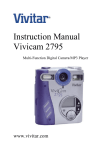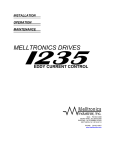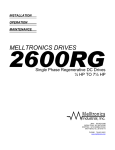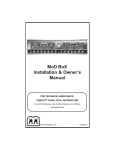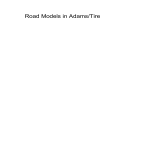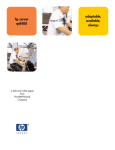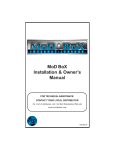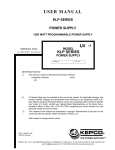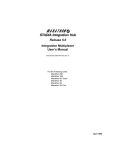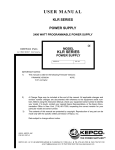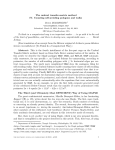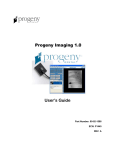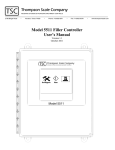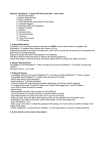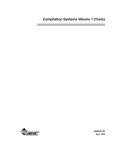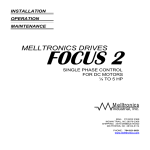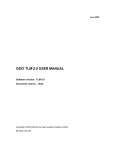Download Melltronics 2700 User Manual
Transcript
INSTALLATION OPERATION MAINTENANCE MELLTRONICS DRIVES SINGLE PHASE NON-REGENERATIVE DC DRIVE CONTROLLER ¼ HP TO 5 HP MAIL: PO BOX 2368 INDIAN TRAIL, NC 28079-2368 SHIPPING: 3479 GRIBBLE ROAD MATTHEWS, NC 28104-8114 PHONE: 704-821-6651 www.melltronics.com SAFETY WARNINGS: Improper installation or operation of this drive control may cause serious injury to personnel or equipment. Before you begin installation or operation of this equipment you should thoroughly read this instruction manual and any supplementary operating instructions provided. The drive must be installed and grounded in accordance with local and national electrical codes. To reduce potential of electric shock, disconnect all power sources before initiating any maintenance or repairs. Keep fingers and foreign objects away from ventilation and other openings. Keep air passages clear. Potentially lethal voltages exist within the control unit and connections. Use extreme caution during installation and start-up. BRANCH CIRCUIT PROTECTION: Branch circuit protection is to be provided by end user, if not included. INITIAL CHECKS: Before installing the drive control, check the unit for physical damage sustained during shipment. Remove all shipping restraints and padding. INSTALLATION LOCATION OF CONTROL: Controls are suitable for most factory areas where industrial equipment is installed. The control and operator’s control station should be installed in a well-ventilated area. Locations subject to steam vapors or excessive moisture, oil vapors, flammable or combustible vapors, chemical fumes, corrosive gases or liquids, excessive dirt, dust or lint should be avoided unless an appropriate enclosure has been supplied or a clean air supply is provided o to the enclosure. The location should be dry and the ambient temperature should not exceed 104 F for an o enclosed unit or 131 F for a chassis mount unit. If the mounting location is subject to vibration, the enclosure should be shock-mounted. If the enclosure has a ventilating fan, avoid, wherever possible, and environment having a high foreign-matter content; otherwise the filters will have to be changed more frequently or micron-filters installed. Should a control enclosure require cleaning on the inside, a low pressure vacuum cleaner is recommended, not an air hose, because of the possible oil vapor in the compressed air and its high pressure. ES2700 – RECEIVING INFORMATION Please record the following before installing the unit and use these numbers when communication with the factory. MODEL NAME PART NUMBER SERIAL NO. REVISION MODIFICATIONS ACCEPTANCE: Carefully inspect shipment upon arrival and check items with packing list. Shortage or damage should be reported promptly to the carrier and your distributor. ES-2700 MANUAL TABLE OF CONTENTS SECTION 1 1.1 1.2 1.3 1.4 INTRODUCTION..........................................................................................................................................................5 GENERAL DESCRIPTION...........................................................................................................................................5 TYPICAL PACKAGING ................................................................................................................................................5 EQUIPMENT IDENTIFICATION ..................................................................................................................................6 SECTION 2 2.1 2.2 2.3 2.4 2.5 2.6 2.7 2.8 OPERATION AND START-UP PROCEDURE .............................................................................. 18 INTRODUCTION........................................................................................................................................................18 OPERATOR CONTROLS ..........................................................................................................................................18 ADJUSTMENTS.........................................................................................................................................................21 JUMPER PROGRAMMING........................................................................................................................................22 START-UP PROCEDURE .........................................................................................................................................24 SECTION 6 6.1 6.2 6.3 6.4 6.5 INSTALLATION ............................................................................................................................. 13 SAFETY WARNINGS.................................................................................................................................................13 INITIAL CHECKS .......................................................................................................................................................13 DETERMINING THE CONTROL LOCATION ............................................................................................................13 INSTALLING CHASSIS MOUNT CONTROLS...........................................................................................................13 INSTALLING ENCLOSED CONTORLS.....................................................................................................................13 POWER WIRING .......................................................................................................................................................13 CONTROL LOGIC WIRING .......................................................................................................................................14 SIGNAL WIRING........................................................................................................................................................14 CIRCUIT BOARD INTERCONNECTIONS.................................................................................................................14 INSTALLING MODIFICATIONS .................................................................................................................................15 SECTION 5 5.1 5.2 5.3 5.4 5.5 FUNCTIONAL DESCRIPTION....................................................................................................... 10 GENERAL DESCRIPTION.........................................................................................................................................10 POWER CONVERSION ASSEMBLY ........................................................................................................................10 REGULATOR ASSEMBLY.........................................................................................................................................10 SECTION 4 4.1 4.2 4.3 4.4 4.5 4.6 4.7 4.8 4.9 4.10 CONTROL SPECIFICATIONS AND FEATURES ........................................................................... 7 EQUIPMENT RATINGS ...............................................................................................................................................7 PERFORMANCE FEATURES .....................................................................................................................................7 PROTECTIVE FEATURES ..........................................................................................................................................8 PERFORMANCE SPECIFICATIONS...........................................................................................................................8 OPERATING CONDITIONS.........................................................................................................................................8 ENVIRONMENTAL CONDITIONS ...............................................................................................................................8 ADJUSTMENTS...........................................................................................................................................................9 CONTROL DIMENSIONS AND WEIGHTS..................................................................................................................9 SECTION 3 3.1 3.2 3.3 SAFETY............................................................................................................................................ 5 MAINTENANCE AND TROUBLESHOOTING............................................................................... 27 IMPORTANT SAFEGUARDS ....................................................................................................................................27 ROUTINE MAINTENANCE ........................................................................................................................................27 TROUBLESHOOTING ...............................................................................................................................................27 CORRECTIVE ACTION FOR DRIVE MALFUNCTIONS............................................................................................28 SCR REPLACEMENT................................................................................................................................................30 SECTION 7 ORDERING SPARE PARTS.......................................................................................................... 31 SECTION 8 SUPPLEMENTARY TECHNICAL INFORMATION ....................................................................... 32 SECTION 9 WARRANTY ................................................................................................................................... 39 MELLTRONICS -3- REV. 04/03/2006 ES-2700 MANUAL LIST OF TABLES Table 1: Armature Circuit Rating Table..................................................................................................................... 7 Table 2: MELLTRONICS ES-2700 Field Data .......................................................................................................... 7 Table 3: MELLTRONICS ES-2700 Weights and Dimensions .................................................................................. 9 Table 4: Armature Current Overload Scaling.......................................................................................................... 23 Table 5: Recommended Spare Parts for the ES-2700 ........................................................................................... 31 Table 6: Terminal Strip Connections....................................................................................................................... 33 Table 7: Jumper Programming Quick Guide........................................................................................................... 33 LIST OF FIGURES Figure 1: Typical Chassis Mount Control ................................................................................................................... 5 Figure 2: Typical MELLTRONICS ES-2700 Nameplate ........................................................................................... 6 Figure 3: Product Nameplate Location ..................................................................................................................... 6 Figure 4: ES-2700 Block Diagram .......................................................................................................................... 12 Figure 5: Connector J1 Pin Assignments................................................................................................................ 15 Figure 6: User Connection Diagram ....................................................................................................................... 16 Figure 7: Upper PC Board....................................................................................................................................... 17 Figure 8: Lower PC Board....................................................................................................................................... 17 Figure 9: Inverse Time Trip Overload Characteristics ............................................................................................ 18 Figure 10: Upper Control Board Operating Features.............................................................................................. 20 Figure 11: Stability Effects on the Velocity Profile .................................................................................................. 21 Figure 12: Lower PC Board Details ........................................................................................................................ 26 Figure 13: SCR Location......................................................................................................................................... 30 Figure 14: Chassis Mount Control .......................................................................................................................... 32 Figure 15: Enclosed Control.................................................................................................................................... 32 Figure 16: Control Logic and Test Meter Connections ........................................................................................... 34 Figure 17: Interconnect Diagram 272-1000-I, Sheet 1 ........................................................................................... 35 Figure 18: Interconnect Diagram 272-1000-I, Sheet 2 ........................................................................................... 36 Figure 19: Top PC Board Schematic - Diagram 272-1000 ..................................................................................... 37 Figure 20: Bottom PC Board Schematic - Diagram 272-1005................................................................................ 38 MELLTRONICS -4- REV. 04/03/2006 ES-2700 MANUAL SECTION 1 SAFETY 1.1 INTRODUCTION MELLTRONICS ES-2700 to operate from either 120 or 240 volt AC input power at 50 or 60 Hz. Additional This instruction manual contains installation jumpers program the control to operate as either a information, operating instructions and troubleshooting speed regulator with armature voltage or as a torque procedures for the MELLTRONICS ES-2700 regulator with armature current feedback. Adjustable Speed Non- Regenerative DC Motor The entire 1/4 to 5HP range of applications is covered Control. A comprehensive description of the by two control models (See Table 1). Drive current MELLTRONICS ES-2700 control with detailed product limit and inverse time overload protective circuits for specifications and a complete description of all ratings within this range are calibrated by means of a customer selectable functions and customer jumper change on the main printed circuit board. installable option kits is included. Included in the MELLTRONICS ES-2700 control are The information in this instruction manual will many built-in features. Motor field economy and describe all drive system set-up and operating separately adjustable rates of acceleration and procedure for most drive applications. Also provided deceleration are included on all units. If desired, the is all the information required by the customer to built-in Accel-Decel control ramps can be by-passed install and maintain a MELLTRONICS ES-2700 completely by a jumper change on the control. control. Additional drive system set-up and operating Current compounding can be added to the speed information may be required in some applications. regulator by changing another jumper position. This information will normally be supplied in the form Current limit is normally set by a potentiometer of a system schematic and system interconnection located on the main printed circuit board, but if diagrams. desired, it can be adjusted using a remote mounted Before beginning installing and before performing any potentiometer or a customer supplied voltage signal. start-up or maintenance on the drive system read this An output signal is available for use with one of the instruction manual in its entirety . MELLTRONICS ES-2700 ammeter kits to provide an 1.2 GENERAL DESCRIPTION indication of drive output current without the addition of an ammeter shunt. The MELLTRONICS ES-2700 is a high performance, 1.3 TYPICAL PACKAGING non-regenerative DC motor control. Included are many standard features that are available only as The normal MELLTRONICS ES-2700 control is options on many other regenerative drives. chassis mounted non-enclosed control suitable for Accessibility to all important internal regulator points is subpanel mounting inside a customer furnished provided by terminals on the control. This permits the control enclosure. (see Figure 1) MELLTRONICS ES-2700 to be used in custom engineered applications, as well as in standard speed regulated applications. The MELLTRONICS ES-2700 controls a DC motor’s speed or torque by varying the DC voltage applied to the motor’s armature. Rectilinear phase control assures stable operation at low speeds and low torque where other controls may exhibit instability. The MELLTRONICS ES-2700 control converts single phase AC input power to variable voltage DC output power. In speed regulated applications, the DC output voltage varies as a function of an input reference voltage. (Typically, this input reference voltage is provided by an operator adjustable potentiometer). Changing the speed reference (potentiometer setting) results in a motor speed change. In torque regulated applications, the DC output current varies as a function of an input reference voltage. Changing the torque reference (potentiometer setting) changes the current supplied to the motor and results in a change in motor torque output. The MELLTRONICS ES-2700 is a versatile control. Figure 1: Typical Chassis Mount Control Simple jumpered programming allows the MELLTRONICS -5- REV. 04/03/2006 ES-2700 MANUAL Typically MELLTRONICS ES-2700 controls are furnished without operator’s devices. Terminals are provided on the basic MELLTRONICS ES-2700 control for connection of one or more of the following operator’s devices: Jog Push-button Remote Current Limit Potentiometer Speed Adjust Potentiometer Start Push-button Stop Push-button Customer requirements may dictate that the operator’s devices be mounted on the door of the enclosure. For these applications, see schematic and interconnection diagrams furnished with your control for specific variations in packaging. 1.4 EQUIPMENT IDENTIFICATION Identification of your drive control completely and accurately is necessary when you contact Melltronics Industrial to order spare parts or request assistance in service. Every MELLTRONICS ES-2700 includes a product nameplate located on the right side of the chassis. Record both the part number and serial number for your future reference. MODEL ES2700 ———–———ACINPUT —–———–— V AC 120/240 HZ 50/60 A PH 17 1 —––——–—MAX DC OUT—–———— V DC 90/180 HP 1-2 A 10 KW —————-––FIELD OUT—————– V FL 100/200 A 3 PN SC 2710-1000-I SN Figure 2: Typical MELLTRONICS ES-2700 Nameplate NAMEPLATE Figure 3: Product Nameplate Location MELLTRONICS -6- REV. 04/03/2006 ES-2700 MANUAL SECTION 2 CONTROL SPECIFICATIONS AND FEATURES Common Control Circuit Boards – All ES-2700 2.1 EQUIPMENT RATINGS controls utilize the same PC board regardless of The MELLTRONICS ES-2700 was designed so that a HP, voltage, frequency or control mode. minimum number of different models could be used in Field Economy - Promotes longer life for wound a wide variety of different drive applications. field DC motors. Easily by-passed or time delayed to meet specific application requirements. Two ES-2700 control models cover the entire ¼ to 5 Inner Current Loop Regulator - Inherent high HP range of DC drive applications. ES-2700 controls band width capability for fast response. are reconnectable for 120VAC or 240VAC single Circuit Board Indicators - Light emitting diodes phase input at either 50 or 60Hz. One control model (LEDs) on the main printed circuit board indicate: covers ¼ through 1 HP applications at 120VAC input DC Overload DC Power ON and ½ through 2 HP applications at 240VAC input. A Field Loss Jog Mode second control model covers 3 to 5HP applications at Instantaneous Overcurrent Trip 240VAC input. Drive current limit and inverse time Run Mode SCRs Being Gated overload protective circuits are calibrated for the Ammeter Output - Motor current can be indicated application by jumper on the main PC board. with the simple addition of a remote meter. Table 1 lists the AC input and DC output current Isolated Control Circuitry - Provides complete ratings by control part number and motor horsepower isolation of the control and regulator circuitry from for all possible combinations. the AC power bus for protection in the event of a ground fault. The speed potentiometer, ammeter Table 1: Armature Circuit Rating Table and tachometer are not at line potential. Complete DC system compatibilities is also possible without AC Armature additional isolation accessories. Input Dual Frequency Operation - Controls may be Control Horsepower Amps @ Amps operated from 50 or 60Hz power supplies by simple 240 @Full jumper change. Part No. 120 VAC Full Load VAC Load Exclusive Static Adjustable Current Limit Permits static setting of the desired current limit 1/4 1/2 4.2 3 value without applying DC power and without a 1/3 — 5.6 4 connected output load when the optional test meter — 3/4 5.6 4 272-8000 is connected. 1/2 1 8.5 6 Jog Set at Preset Speed - Separately adjustable 3/4 1 1/2 11 8 from zero to 50% of base speed. 1 2 14 10 Negative IR Compensation - enables this drive to operate in load sharing applications. This feature — 3 21 14 becomes available by jumper connection. — — 28 20 272-8001 Speed Regulator – Two percent accuracy using — 5 38 25 armature voltage feedback with IR compensation of A fixed voltage unregulated DC motor field supply is 1% accuracy with tachometer feedback. Regulation provided on all MELLTRONICS ES-2700 controls. may be improved by selecting the proper motor The DC voltage output level is a function of the AC mounted tachometer. voltage input level. Field data for the MELLTRONICS Separately Adjustable Linear Accel/Decel ES-2700 control is tabulated in Table 2. Control - Two ranges; 0.2-4 seconds and 2-30 Table 2: MELLTRONICS ES-2700 Field Data Voltage: 100 VDC with 120 VAC input 200 VDC with 240 VAC input Current: 3 amperes maximum 2.2 PERFORMANCE FEATURES Every ES-2700 control includes the following standard features and functions: Current (Torque) Regulator - One percent accuracy armature current regulator allows the operator to control motor torque instead of speed. MELLTRONICS -7- seconds. Solid State Full Wave Power Bridge - Provides generously rated power semiconductors for maximum reliability and long life. Standard Adjustments – Maximum speed, minimum speed, IR compensation, acceleration time, deceleration time, current limit, jog speed, velocity stability, speed rate and current stability. Remote Current Limit - Available by the simple addition of a potentiometer of DC voltage input. REV. 04/03/2006 ES-2700 MANUAL SCR Trigger Circuits - Pulse transformer isolated, hard firing, high frequency “burst” type pulse train output from individually gated oscillators insures SCR conduction regardless of the effects of line notching on the incoming AC power line. AC Line Filter and Transient Voltage Suppressor Network - Eliminates interaction between other drives or AC equipment. Power Supplies – Each ES-2700 contains an internal 115 VAC power supply to power the DC loop contactor and drive logic relays. Internal ±24VDC, ±15VDC and a regulated –10VDC power supply are also included. 2.3 PROTECTIVE FEATURES The following list identifies the protective features of the ES-2700. DC Overload (Armature) - Senses over-current conditions with inverse time shutdown. Fault Trip Circuit - Visual indication of the fault condition is provided when a DC overload, field loss, or instantaneous over-current conditions occurs. Protective circuits are designed to quickly shut the drive down whenever a drive fault condition occurs. A fault trip circuit prevents unintended drive restart after a fault has occurred and must be reset before the drive can run again. Field Loss Protection - Protects against runaway due to loss of motor field by shutting down the drive. Double Break DC Armature Loop Contactor Full rated and fully sequenced contactor assures positive disconnect of DC motor when the stop push-button is pushed or whenever an undervoltage condition occurs. High Speed Current Limiting SCR Semiconductor Fuses - Gives the ultimate in fuse coordination and protection of the SCRs and motor with positive circuit clearing on both AC and DC faults. Reactors, Snubber Networks - Prevents interaction and SCR DV/DT failures, due to line spikes and transients. Provides DI/DT protection during SCR turn-on and aids in SCR turn-off during SCR commutation, therefore minimizing the effects of AC power-line notching. Instantaneous Overcurrent Protection – Senses armature fault currents quickly to protect both semiconductors and motors against damaging current levels. NOTE Additional electrical equipment to insure proper control operation may be required for severe system applications. For further information, contact Melltronics Industrial. MELLTRONICS -8- 2.4 PERFORMANCE SPECIFICATIONS 20:1 basic control. May be extended to 200:1 by modification Controlled Speed Range: Speed Regulation: For a 95% Load Change: Voltage Regulated: 2-5% of maximum speed Speed Regulated: 1% of maximum speed with any DC tachometer. For All Other Variables: Voltage Regulated: Changes up to 15% of top speed can result from temperature variations, voltage and frequency variations, and drift. Speed Regulated: 1% of maximum speed with any DC tachometer 2% of maximum speed with any AC tachometer NOTE Speed regulation may be modified to achieve 0.1% due to a 95% load change and 0.15% due to all other variables. Overload Capacity: 150% of related current for 1 minute Service Factor: 1.0 2.5 OPERATING CONDITIONS Rated Line Voltage: Line voltage Variations: 120 or 240VAC , SinglePhase ±10% Rated Line Frequency: 50 or 60Hz ±2Hz ENVIRONMENTAL CONDITIONS Line Frequency Variations: 2.6 0 0 0 0 Storage Temperature: -30 C to 65 C (-20 F to 150 F) Ambient Temperature (Enclosed Control): Ambient Temperature (Chassis Mount Control): Altitude: 00 C to 400 C (320 F to 1040 F)* 00 C to 550 C (320 F to 1310 F)* Sea level to 3300 feet *(1000 meters) Relative Humidity: 0 to 95% *Operation at elevated temperature and higher altitudes requires derating of the control. REV. 04/03/2006 ES-2700 MANUAL 2.7 ADJUSTMENTS The MELLTRONICS ES-2700 control includes a number of potentiometers that may require adjustment during drive installation and start-up. These adjustment potentiometers are located on the main (regulator) PC board. 2.8 Vel. Stability User adjusted for best results Deceleration User adjustable from 0.2-4 sec. or 2-30 sec. (selectable) Time Acceleration Time CAUTION ANY ALTERNATION TO FACTORY-ADJUSTED POTENTIOMETERS MAY CAUSE EQUIPMENT DAMAGE AND/OR MACHINERY PROCESS PROBLEMS. FOR FURTHER ADJUSTMENTS, CONTACT: MELLTRONICS INDUSTRIAL, INC. User adjustable from 0.2-4 sec. or 2-30 sec. (selectable) CONTROL DIMENSIONS AND WEIGHTS Table 3 gives the approximate weight and dimensions for various MELLTRONICS ES-2700 controls. Figure 14 shows the outline and mounting dimensions for these MELLTRONICS ES-2700 controls. Maximum Speed User adjustable from 70-130% of rated speed. User adjustable from 0-50% of rated speed Current Stability User adjustable for best results Speed Rate User adjustable for best results. Table 3: MELLTRONICS ES-2700 Weights and Dimensions Jog Speed IR Compensation Min Speed I Limit Control Type User adjustable from 0-15% of rated voltage. User adjustable from 0 to 30% of rated speed. User adustable from 0-150% of selected current range Approximate Weight (lbs) Approximate Dimensions Chassis Mount 10 13.0 x 9.5 x 4.75 Chassis Mount with Test Meter 10 13.0 x 9.5 x 7.0 Included on the MELLTRONICS ES-2700 are several additional adjustment potentiometers. These potentiometers are all factory set and normally do not require further adjustment. MELLTRONICS -9- REV. 04/03/2006 ES-2700 MANUAL SECTION 3 FUNCTIONAL DESCRIPTION The ES-2700 is a non-regenerative DC motor control supply anytime the DC loop contactor is opened. This which consists of two basic functional blocks: a power reduces the field voltage applied to the DC motor conversion assembly and a regulator assembly. (field economy) and helps to increase motor life in the applications where the motor field remains energized 3.1 GENERAL DESCRIPTION while the motor is stopped. The power conversion assembly consists of two The control power supply assembly steps down the silicon controlled rectifiers (SCRs) and two diodes incoming AC line voltage, and then rectifies filters and connected in a full wave bridge configuration, with a regulates it to provide two DC power sources third “freewheeling” diode connected across the (±24VDC and ±15VDC) that are used internally by the armature output terminals of the bridge. Normally ES-2700 regulator assembly. reverse biased, this “freewheeling” diode conducts A –10VDC output is also produced which may be only when both SCRs have been commutated off, used in conjunction with an external potentiometer to allowing the current in the armature circuit a path to create a drive reference signal. The control power circulate. supply assembly includes a fused and isolated The Regulator Assembly includes all of the electronic 115VAC power source that is used to operate the circuitry used to control (provide gating signals to) the control logic relays and DC loop contactor. Power Conversion Assembly. The regulator used in All of the remaining functional blocks shown in Figure the ES-2700 employs two control loops – an outer 4 are functional blocks associated with the ES-2700 velocity loop and an inner current loop. There are regulator assembly. An overview of the ES-2700 several advantages inherent in a DC motor control regulator assembly follows. that employs this dual control loop concept. First of 3.3 REGULATOR ASSEMBLY all, the inner current loop can easily and effectively be The ES-2700 control works off of a zero to –10VDC used to limit DC motor armature current. This protects reference signal. This input reference signal can the motor, the power bridge, and the fuses during represent either a DC motor speed reference or a DC stable drive operation under varying load conditions. motor torque reference depending on the placement Another advantage of a DC motor control that of a terminal board jumper (this will be explained employs an inner current loop is the ease with which it later). The input reference signal is usually introduced can be converted from speed regulated drive to a to the control at terminal #12 (TB-1) on the regulator torque regulated drive. This provides application (top) printed circuit board. flexibility that would not otherwise be available. In the following section, the ES-2700 will be analyzed 3.3.1 ACCEL/DECEL CIRCUIT and described using the functional block diagram Terminal #12 is connected to the input of the ES-2700 shown in Figure 4. accel/decel (reference ramp) circuit. This circuit 3.2 POWER CONVERSION ASSEMBLY controls the rate at which the drive reference can change. When a reference signal is applied to the Incoming AC power is applied to the ES-2700 control input of the accel/decel circuit, the output of the at terminals L1 and L2. A pair of current limiting type accel/decel circuit changes at a linear rate with fuses (1FU and 2FU) provides AC line short circuit respect to time until the output of the accel/decel protection and serves to protect the SCRs from DC circuit TB-1, Terminal #3 is equal to its input (Terminal fault currents. AC line power is distributed within the #12). The rate of change is adjustable and separate ES-2700 control to three major functional blocks: the adjustments are provided for positive going and power conversion assembly, the DC motor field negative going reference changes. The accel/decel supply and the control power supply. (ramp reference) circuit is most commonly used in The power conversion assembly consists of a single speed regulated drive applications. If the operator phase controlled, full wave rectified, SCR power rapidly changes the speed reference to the drive, the conversion assembly. The output of the power accel/decel circuit will limit the acceleration of conversion assembly is connected to the DC motor deceleration rate to a rate that will not cause machine armature through a DC loop contactor (M). The DC or process problems. The accel/decel (reference loop contactor provides a positive means of ramp) circuit can also be used in torque-regulated disconnecting the DC motor armature from the power applications to limit the rate at which the torque conversion assembly in the event of a drive fault. reference to the drive can change. The DC motor field supply rectifies AC line voltage to The output of the accel/decel circuit (TB-1 Terminal produce a fixed DC voltage that may be connected to #3) is usually connected to the velocity error amplifier the field windings of a wound field DC motor. The input (Terminal #4) via a jumper connection at the field power supply produces an output of 200VDC with customer terminal strip (TB-1). It is possible to by240VAC input or 100VDC with a 120VAC input. An pass the accel/decel circuit completely by connecting auxiliary contact (MAUX) “half waves” the field power MELLTRONICS - 10 - REV. 04/03/2006 ES-2700 MANUAL the drive input reference signal to Terminal #4 instead of terminal #12 and removing the jumper between Terminals #3 and #4. The accel/decel circuit is often by-passed in custom engineered drive applications.. 3.3.2 VELOCITY ERROR AMPLIFIER The velocity error amplifier circuit is used in speed regulated drive applications. It compares a velocity reference signal with a velocity feedback signal to determine whether the DC motor is operating faster or slower than its commanded velocity. The output of the velocity error amplifier circuit is used as a reference signal to the ES-2700’s “inner current loop”. The “inner current loop” directly controls DC motor armature current. The feedback signal to the velocity error amplifier can be a signal proportional to DC motor armature voltage or it can be a signal from a DC tachometer generator. Armature voltage feedback is used in those applications where the speed regulation and drift characteristics (See section 2.4). The velocity feedback selection and scaling circuitry allows the control to be programmed for armature voltage feedback or tachometer feedback. It allows the control to be used with 90VDC or 180VDC motors (voltage regulated applications) or with a variety of tachometer voltage output levels (speed regulated applications). The velocity error amplifier circuit has one additional input, IR compensation. 3.3.3 IR COMPENSATION The IR compensation network introduces an increase or decrease) in the velocity reference proportional to motor armature current. The magnitude of the increase (or decrease) can be adjusted using the IR compensation potentiometer. On the ES-2700 the IR compensation signal can be either positive or negative. Positive IR compensation increases the motor velocity reference as the motor armature current increases. Positive IR compensation is used in armature voltage regulated control applications to offset the natural tendency for the speed of a motor to decease as the load on the motor increases. Positive IR compensation is generally not used in applications that employ tachometer feedback. Negative IR compensation is just the opposite of positive IR compensation. It causes the motor velocity reference to decrease as motor armature current increases. When negative IR compensation is employed, the DC drive motor will function much like a compound wound DC motor would function in the same application. Negative IR compensation is used in “helper drive” applications where the speed of the drive must conform to the speed of the process it drives. Negative IR compensation may be used with both armature voltage and tachometer feedback regulated controls. MELLTRONICS - 11 - 3.3.4 ARMATURE CURRENT ERROR AMPLIFIER The armature current error amplifier compares an armature current reference signal (the output of the velocity error amplifier) with an armature current feedback signal (the output of the armature current scaling amplifier). The output of the armature current error amplifier is one of two reference signals applied to the phase angle reference circuitry. 3.3.5 PHASE ANGLE REFERENCE The phase angle reference circuitry determines the correct SCR firing angle for the SCR power conversion assembly. Actual SCR firing is controlled by the SCR gating circuit. 3.3.6 CURRENT SENSING TRANSFORMER (CT1) A current sensing transformer (CT1) measures the AC line current flowing in the power conversion assembly. The CT output waveform is rectified and normalized by the armature current scaling amplifier to provide a signal that is directly proportional to the current flowing in the DC motor. This signal is utilized as the feedback signal to the armature current error amplifier and it is also used as an input to the IR compensation circuitry. 3.3.7 ARMATURE VOLTAGE BUFFER/SCALING AMPLIFIER The armature voltage buffer/scaling amplifier is used to isolate and scale the DC motor armature voltage for use by the phase angle reference circuit. The output of the armature voltage buffer/scaling amplifier is also used as “velocity” feedback in some applications. The velocity error amplifier circuit is designed to function normally as a very high gain error amplifying circuit. It can also be configured to function as a low gain, input reference buffer amplifier. This configuration is normally used in current regulated drive applications. By jumpering Terminals #1 and #2 at the user terminal board (TB-1) and eliminating both the armature voltage and tachometer feedback signals, it is possible to reconfigure the ES-2700 to function as a current (torque) regulated DC drive control. When configured in this manner, the input reference signal applied to TB-1 Terminals #12 (or Terminal #4) will control DC motor current (torque) instead of DC motor speed. Drive current limit is typically set using a potentiometer located on the ES-2700 control. In many applications, it is desirable to adjustable drive current limit using either a remote mounted potentiometer or a customer supplied voltage signal. A 0 to –12VDC signal applied to Terminal #15 (TB-1) adjusts drive current limit between 0 and 150% of the selected current range. REV. 04/03/2006 MELLTRONICS 2FU L2 - 12 - REMOTE CURRENT LIMIT INPUT OVDC TO -12VDC CURRENT REGULATION TACH FEEDBACK (LOW) TACH FEEDBACK (MED) TACH FEEDBACK (HIGH) ARMATURE FEEDBACK JUMPER FOR: ACCEL/DECEL REFERENCE INPUT -10 VDC TO 0 VDC 1FU L1 15 2 1 17 18 19 20 21 4 3 14 12 CONTROL POWER SUPPLY DECEL VELOCITY FEEDBACK SELECTION & SACLING CIRCUITRY MAX SPEED ACCEL ACCEL/DECEL (REF. RAMP) CIRCUITRY IR COMP + - IR COMPENSATION NETWORK CONTROL (RELAY) LOGIC VELOCITY ERROR AMPLIFIER CIRCUIT DC MOTOR FIELD SUPPLY M AUX A- M CT1 PHASE ANGLE REFERENCE CIRCUITRY SCR GATING CIRCUITS POWER CONVERSION ASSEMBLY interconnect2.vsd:p1 A-5 REV. 03/02/2006 NOTICE: This drawing is furnished for reference only. The furnishing or possession of this drawing or any reproduction thereof, does not convey any manufacturing rights. ARMATURE CURRENT BUFFER/ SCALING AMPLIFIER 90VDC 180VDC ARMATURE CURRENT ERROR AMPLIFIER CURRENT LIMIT MOTOR ARMATURE ARMATURE CURRENT SCALING AMPLIFIER LOW MED HIGH F- F+ A+ ES-2700 MANUAL Figure 4: ES-2700 Block Diagram REV. 04/03/2006 ES-2700 MANUAL SECTION 4 INSTALLATION 4.1 SAFETY WARNINGS Improper installation or operation of this control may cause injury to personnel or equipment. Read the operating instructions. The control and its associated motors and operator control devices must be installed and grounded in accordance with all local codes and the national electrical code. To reduce the potential for electric shock, disconnect all power sources before initiating any maintenance or repairs. Potentially lethal voltages exist within the control unit and connections. Use extreme caution during installation and start-up. 4.2 INITIAL CHECKS Before installing the drive control, check the unit for physical damage sustained during shipment. Remove all shipping restraints and padding Check nameplate data for conformance with the AC power source and motor. 4.3 DETERMINING THE CONTROL LOCATION The ES-2700 is suitable for most well ventilated factory areas where industrial equipment is installed. Locations subject to steam vapors or excessive moisture, oil vapors, flammable vapors, chemical fumes, corrosive gases or liquids, excessive dirt, dust or lint should be avoided unless an appropriate enclosure has been supplied or a clean air supply is provided to the enclosure. The location should be dry and the ambient temperature should not exceed 40oC If the mounting location is subject to (104oF). vibration, the unit should be shock mounted. If the enclosure is force ventilated, avoid, wherever possible, an environment having high foreign-matter content, as this requires frequent filter changes or the installation of micron filters. Should a control enclosure require cleaning on the inside a lowpressure vacuum cleaner is recommended. Do not use an air hose because of the possibility of oil vapor in the compressed air and the high air pressure. 4.4 INSTALLING CHASSIS MOUNT CONTROLS The chassis mount ES-2700 is suitable for mounting in a user’s enclosure where internal temperature will not exceed 55oC (131o F). The following instructions are recommended: Mount the chassis vertically against the mounting surface. Dimensions are shown in Figure 14. A minimum clearance of 3 inches around the ES-2700 is recommended for proper cooling when installing a chassis mount control. MELLTRONICS - 13 - CAUTION NEVER OPERATE THE CONTROL FOR AN EXTENDED PERIOD OF TIME ON ITS BACK. DOING THIS WILL CAUSE THE HEAT FROM THE HEAT SINKS TO PENETRATE THE CONTROL LOGIC WIRING. 4.5 INSTALLING ENCLOSED CONTORLS Enclosed ES-2700 controls are suitable for wall mounting in an ambient atmosphere between 0oC (32oF) and 40oC (104oF). Mount the control so that there is access to the front panel. See Figure 15 for Never operate the control for an dimensions. extended time on its back for the reason explained in section 4.4. 4.6 POWER WIRING The ES-2700 control will operate from typical AC power lines. The line should be monitored with an oscilloscope to insure that transients do not exceed limitations as listed below: Repetitive line spikes of less than 10 microseconds must not exceed the following magnitude: 120 Volt Drives 200 V. Peak 240 Volt Drives 400 V. Peak Non-repetitive transients must not exceed 25watt seconds of energy. Transients of excessive magnitude or time duration can damage dv/dt networks or surge suppressors. Line notches must not exceed 300 microseconds in duration. An abnormal line condition can reflect itself as an intermittent power unit fault. High amplitude spikes or excessive notch conditions in the applied power could result in a power unit failure. Refer to Figure 5 for power wiring connections. The ES-2700 is insensitive to the AC line phase sequencing. Designation of inputs L1 and L2 is arbitrary. CAUTION A SEPARATE FUSED DISCONNECT OR CIRCUIT BREAKER SHALL BE INSTALLED IN THE INCOMING AC POWER LINE TO THE CONTROL, AS PER THE NATIONAL ELECTRICAL CODE. Use the AC line current specified on the nameplate of the control being installed to size the AC input wiring. Size the motor leads according to the motor nameplate current ratings following NEC requirements. Connect the armature leads to the terminal lugs marked A+ and A- on contactor MC located above the upper right hand corner of the lower PC board. Consult the motor connection diagram supplied with the motor for proper polarity. REV. 04/03/2006 ES-2700 MANUAL Check that the proper number of turns of the armature lead (from the SCR to the contactor) have been made around transductor CT1. The low (1/4-2) HP control should have 5 turns. The high (3-5) HP control should have 2 turns. Connections to the motor field should be made with due consideration to the proper polarity. Consult the motor connection diagram. The ES-2700 field supply provides 100VDC when the control is wired to a 120VAC line and 200VDC when wired to a 240VAC line. The field supply provides 50VDC or 100VDC respectively when the field economy feature is wired in, AC power is applied to the control, and the loop contactor is open. NOTE The ES-2700 is shipped for the factory with the field economy feature wired for operation. It is recommended that this feature not be by-passed. It reduces the voltage to the motor field when the control is stopped but not removed from the AC input line. If the field economy feature is not used, then these terminals must be jumpered together. All power connections (i.e., armature, line voltage) are made to the lower PC board through faston connections. In cases where polarity or phasing is critical, two different size fastons are used to insure proper polarity. Verify that the input voltage and frequency select program jumpers A, B and L-M are correct for your application. The ES-2700 is shipped programmed for: 60Hz 240VAC High voltage armature feedback. NOTE A functional description of all jumpers is contained in Section 5, Operation and Startup Procedure. Check that all program jumpers are correct for you application. CAUTION NO POINTS IN THE CONTROL CIRCUITRY, INCLUDING COMMON, SHOULD BE CONNECTED TO EARTH GROUND UNLESS SPECIFICALLY SHOWN ON SYSTEM DIAGRAMS. CONNECT EARTH GROUND TO THE GROUND LUG BESIDE 3FU AND 4FU ON THE HEAT SINK CHASSIS ASSEMBLY. WHEN READY TO APPLY POWER TO THE ES-2700, CONNECT THE 120VAC OR 240VAC SUPPLY LINES TO TERMINALS L1 AND L2 ON FUSE BLOCKS 3FU AND 4FU ON THE HEAT SINK/CHASSIS ASSEMBLY. 4.7 CONTROL LOGIC WIRING Terminal strip TB-2 consists of two sections of terminal block. Terminals #1 through #15 are located along the left edge of the lower control board. Terminals #16 through #25 are along the bottom. Terminals #1 through #21 are used for control logic. See Table 6, Figure 6 and Figure 16 for terminal strip connections. A detailed description of control logic MELLTRONICS - 14 - functions is contained in SECTION 5. The wiring of the lower PC board is shown in Figure 20. 4.8 SIGNAL WIRING Terminals #1 through #21 on terminal strip TB-1 are used for connection drive reference and feedback signals to the ES-2700. Terminals #1 through #15 are along the left edge. Terminals #16 through #21 are located along the bottom edge of the upper control board. See Table 6, Figure 6 and Figure 16 for terminal strip connections. The wiring of the upper PC board is shown in Figure 19. NOTE It is recommended that shielded wire be used for reference, tachometer, optional ammeter and other signal wire connections. Belden #83394 (2 conductor) and Belden #83395 (3 conductor) shielded wire (or equivalent) is recommended. The shields should be taped off at the remote end. At the drive control, the shields should be connected to common, TB-1 terminal 14. Additional consideration is recommended to route this wiring away from high current lines (i.e., AC line and armature wiring). 4.9 CIRCUIT BOARD INTERCONNECTIONS There are six (6) multi-pin connectors used in the ES2700 to supply power and transmit control signals for the upper and lower PC boards. J1 is a 15 pin AMP connector that attaches to the upper right hand side of the lower PC board. It supplies power to the board from the AC inputs L1 and L2 and, in turn, feeds the primary of the control transformer. It also supplies AC power from the control transformer secondary to the DC power supplies and the 120VAC control logic. See Figure 5 for pin assignments. CAUTION CARE MUST BE TAKEN TO ALIGN THE PINS AND JACKS ON THE FOLLOWING MOLEX CONNECTORS TO AVOID WRONG CONNECTIONS AND DAMAGE TO THE CONTROL. J2 is a 2 pin AMP connector located on the top edge of the lower PC board. The armature current feedback signal from transductor CT1 flows through J2. J3 is a 15 pin Molex connector located in the center of the top edge of the lower PC board. It provides a quick means of connecting the optional test meter kit to the ES-2700. (The optional test meter kit will be discussed later in this section.) See Figure 16 for pin assignments. REV. 04/03/2006 ES-2700 MANUAL J4 is a 16-pin ribbon connector that supplies ± 15VDC power, circuit common and the raw sync signal to the upper PC board. It is located on the back of the upper PC board in the top right hand corner. See Figure 16 for pin assignments. J5 is a 16-pin ribbon connector located on the back of the upper PC board in the bottom right hand corner. It provides feedback and control signals from the lower PC board. See Figure 16 for pin assignment. J6, located on the bottom right hand corner of the lower PC board, is a 2-pin AMP connector. It supplies the gate pulse signals from the firing circuitry to the SCR gates. See Figure 12. J1 13 10 7 X X X 15 INSTALLING MODIFICATIONS 4.10 4.10.1 TEST METER The test meter kit, available for use in starting up and troubleshooting the ES-2700, screws down onto the upper PC board of the control. It is easily connected by installing the Molex connector, wired to the test meter PC board, into connector J3 on the lower PC board of the ES-2700. This modification consists of a digital panel meter and multi-position selector switch. It provides the capacity to monitor nine critical drive parameters, including: Field Voltage Line Voltage Control Voltage Armature Voltage Armature Current (%) Current Limit (%) Trigger Signal Negative 15 VDC Reference Positive 15 VDC Reference Pin # 3 Input to Control Transformer from: AC Line L2 Input Voltage 6 B 12 A Program Jumpers (to center tap) 15 Fused AC Line L1 12 X 4 X 6 1 X 3 X = NOT USED Pin # 1 4 7 13 10 From Output of Control Transformer to: 120VAC Control Power Fused 120 VAC Control Power Rectifier for DC Power Supplies Common Figure 5: Connector J1 Pin Assignments MELLTRONICS - 15 - REV. 04/03/2006 MELLTRONICS - 16 - STOP 9 START 10 CRR 11 CRR 12 JPG 13 CRJ 24 user connection diagram rotate.vsd REV. 03/02/2006 OPTIONAL AMMETER A 25 LOWER PC BOARD NOTICE: This drawing is furnished for reference only. The furnishing or possession of this drawing or any reproduction thereof, does not convey any manufacturing rights. MOTOR THERMAL E-STOP 8 120 VAC TB2 CRR SOLID LINE- USER CONNECTION DOTTED LINES - FACTORY CONNECTION 3 FU 4FU USER SUPPLIED CICUIT BREAKER OR FUSED DISCONNECT 2 FU 1 FU TB1 F + FIELD F- 12 13 14 - 16 COM MC A- + 18 LOOP CONTACTOR A+ DRIVE CONTROL IS SUPPLIED CONNECTED FOR ARMATURE VOLTAGE FEEDBACK, IF TACHOMETER FEEDBACK IS REQUIRED CONNECT THE TACHOMETER AS SHOWN AND SEE PARAGRAPH 5.4 FOR JUMPER REQUIREMENTS SPEED POT -10 VDC 11 T FE2 MC FE1 LOWER CHASSIS/HEAT SINK ASS'Y GN D UPPER PC BOARD L2 L1 A.C. SUPPLY EARTH GROUND ARMATURE ES-2700 MANUAL Figure 6: User Connection Diagram REV. 04/03/2006 ES-2700 MANUAL 4.10.2 AMMETER KIT 4.10.3 REMOTE CURRENT LIMIT The ES-2700 includes circuitry to drive an external ammeter without the addition of an ammeter shunt. This external meter can be calibrated in either percent load or in amperes. As shipped, the control has a minimum 100% current output rating of 6 amps. For applications below 1HP at 240VAC (1/2HP at 120VAC input), the built-in DC overload protection will be scaled for too much output current and will not function. To provide overload protection and properly calibrate the ammeter kit, removal of jumper N-O is required. The appropriate current range jumper settings are given in SECTION 5. TB-2, terminals #24, located at the bottom of the lower PC board (see Figure 6), are for connecting the optional external ammeter. This meter should have a 0-100 μA movement, 3700Ω coil resistance and read 150% current full scale. A 200% full scale ammeter can be used when jumper JP-1 is removed from the lower PC board. A complete line of ammeters for the ES-2700 is available from Melltronics. Consult the web site, www.melltronics.com, and SECTION 5 of this manual for assistance in ordering a meter. A potentiometer to modify the current limit setting of the ES-2700 from a remote location may be installed. The voltage signal from the wiper of the potentiometer is wired to TB-1 terminal 15. A –12V signal at that terminal yields 150% current limit. The –10VDC power supply, TB-1 terminal 11 and TB-1 terminal 14 (common) may be used to supply voltage for the remote current limit potentiometer. The equivalent resistance of the remote current limit potentiometer is parallel with the speed reference potentiometer, should not go below 5KΩ as this would excessively load the –10VDC power supply. If remote current limit is used, remove jumper H-1 from the upper PC board and install jumper G-H. This is necessary to eliminate the local current limit potentiometer (on the upper PC board) from the circuit and provide a path for the remote current limit signal to enter the control. Figure 7: Upper PC Board Figure 8: Lower PC Board MELLTRONICS - 17 - REV. 04/03/2006 ES-2700 MANUAL SECTION 5 OPERATION AND START-UP PROCEDURE INTRODUCTION 150% This section describes the operator controls and their functions, initial start-up procedure, and applications adjustments of potentiometers and jumpers for the ES-2700. Read this section thoroughly to develop an understanding of the operation and logic incorporated in the ES-2700. 5.2 120% 110% TIME (MIN) CONTROL VOLTAGE FAULT TRIP RELAY (CRFT) Under normal conditions, this relay is energized when AC power is applied to the ES-2700 control. When energized, CRFT enables the operator control devices by closing the contact that provides control voltage to these devices at terminal TB-2 #8. There are three causes for a fault trip that drops out CRFT. 5.2.2.1 130% 15 Terminals TB-2#1 and #2 provide 120VAC control power for your use. A total of 5VA of power is available for user supplied devices. 5.2.2 140% OPERATOR CONTROLS Refer to Figure 16, Figure 17, Figure 18 and Table 6 for operator control locations. 5.2.1 % RATED CURRENT 5.1 FIELD LOSS The field loss circuit monitors the presence of field current. If field current is absent after the start pushbutton is depressed, the FL LED lights and CRFT drops out. The field loss LED may flash when AC power is first applied and the DC power supplies are coming up to their proper voltages. No fault trip will occur until the start pushbutton is depressed. Figure 9: Inverse Time Trip Overload Characteristics When a fault trip occurs and CRFT drops out, the control voltage to the operator devices is removed and the drive sequences down the same as if the STOP pushbutton were depressed. This sequence is given in the description of the STOP circuit. The three causes of fault trips are sensed by latching type circuits and must be reset using the RESET pushbutton on the upper PC board. A set of form C contacts off of CRFT is available to the user at TB-2 terminals #3, #4, and #5. See Figure 16. 5.2.3 INSTANTANEOUS OVERCURRENT (IFT) A fault trip occurs dropping out CRFT and lighting the IFT LED when an armature current, 300% of the rated current, is detected. 5.2.2.3 INVERSE TIME DC OVERLOAD (DCOL) The DC overload circuit drops out CRFT and lights the yellow DCOL LED when the drive has run at 150% current limit for approximately one minute. Less severe overloading will take longer to trip out. See the inverse time trip characteristic in Figure 9. MELLTRONICS - 18 - MOTOR THERMAL SWITCH/E-STOP Motors with built-in fans may overheat when run for extended periods at low speed. A thermal sensing switch inside the motor will open before overheating occurs. When wired to terminals TB-2 #8 and #9, the open switch will stop the drive to protect the motor. A user supplied, normally closed switch may be wired in series with the thermal switch or in place of it to provide and E-stop function. If neither the thermal switch nor the E-stop is used, TB-2#8 and #9 must be jumpered. The shut-down sequence is the same as the stop function sequence. 5.2.4 5.2.2.2 30 STOP When pressed, the STOP switch interrupts the path that supplies the current to keep the run relay (CRR) energized. This interruption results in the following reaction. The contact that locks in the relay (CRR) is opened, The contacts that permit the jog button to function are closed; The supply voltage that keeps the motor contactor energized is removed; The circuit from the speed potentiometer is open; The accel/decel, and velocity error and current error amplifiers are clamped. REV. 04/03/2006 ES-2700 MANUAL 5.2.5 5.2.9 START When permitted by the fault trip relay (CRFT), the START switch momentarily closes the circuit that energizes relay CRR. When CRR is energized, contacts close that cause the following: CRR is locked on; A path is provided to energize the motor contactor; The reference voltage is connected from the speed pot to the accel/decel circuit; Controls that clamped the accel/decel, and velocity and current error amplifiers are opened; The jog switch that energizes the jog relay (CRJ) is disabled. A set of normally open contacts off of CRR is available between terminals TB-2 #6 and #7. The RUN LED lights when CRR is energized. 5.2.6 JOG When permitted by the run relay (CRR) and fault trip relay (CRFT), the JOG switch completes the circuit to energize the jog relay (CRJ). The jog relay then provides a path to energize the motor contactor and connect the jog reference signal to the jog circuitry. CRJ does not lock in so that when the jog pushbutton is released, the motor contactor drops out and the controller is in a stop condition. A set of N.O. contacts off of CRJ in parallel with N.O. contacts off of CRR is available to the user at terminals TB-2#14 and #15. The jog LED lights when CRJ is energized. 5.2.7 MISCELLANEOUS USER CONNECTIONS Terminal TB-1 #14 is control common Terminals TB-1 #5 through #8 are not for customer use. Terminal TB-1 #15 is the connection for the remote current limit signal covered in section 4.10.3. The field loss detection circuit is disabled when terminals TB 2 #20 and #21 are jumpered together. This is generally not recommended as severe motor and machine damage may result if overspeed occurs due to field loss. Operation as a current regulated drive using terminals TB-1 #1, #2 and #4 is covered in section 5.4.2.8 of this instruction manual. Tachometer feedback and the usage of terminals TB-1#16 through #21 is detailed in section 5.4.2.11 of this manual. Turret terminal ‘S’ on the upper PC board is an armature current signal for factory assembled customer applications and is not calibrated for customer use. A calibrated armature current signal is available at terminal strip TB-2 as explained in section 4.10.2. MOTOR CONTACTOR The motor contactor is factory wired to terminals TB-2 #16 and #17. When energized, the contactor closes the DC loop that energizes the motor armature and the N.O. “A” auxiliary contacts disable the field economy circuit so that the motor receives full field voltage. 5.2.8 SPEED REFERENCE POTENTIOMETER The signal from the speed reference potentiometer wiper is wired to Terminal TB-1 #12. A negative voltage reference signal corresponds to positive armature voltage. Negative 10VDC is available for the speed reference potentiometer at terminal TB-1 #11. The third lead of the speed reference potentiometer is connected to TB-1 terminal #13. This connection provides a voltage bias to the base of the speed reference potentiometer corresponding to minimum speed. This bias is adjusted using the MIN SPEED potentiometer on the upper PC board. MELLTRONICS - 19 - REV. 04/03/2006 TB1 DC POWER MELLTRONICS - 20 - 15 14 13 12 11 10 9 8 7 6 5 4 3 2 1 U TB1 MIN SPEED V 16 17 DECEL TIME 18 19 20 21 MAX SPEED P2 ACCEL TIME BIAS P1 RESET JOG G H D9 I LIMIT I CURR STAB P3 L IFT IR -IR P R CUT FOR 90V ARM W VEL STAB N O T IR COMP HI MED LO upper control bd oper feat rotate.vsd REV. 03/02/2006 NOTICE: This drawing is furnished for reference only. The furnishing or possession of this drawing or any reproduction thereof, does not convey any manufacturing rights. SPEED RATE M ZERO P4 ES-2700 MANUAL Figure 10: Upper Control Board Operating Features REV. 04/03/2006 ES-2700 MANUAL 5.3 ADJUSTMENTS There are ten (10) adjustment potentiometers located on the upper control board (P/N 272-4000) Figure 10. Exercise caution when making adjustments. With the control driving a motor, do not exceed ten (10) degrees of pot rotation per second. 5.3.1 MIN SPEED The MIN SPEED potentiometer adjusts the minimum speed of the drive according to the reference signal from the speed potentiometer. Minimum reference is from 0-30% of full rated speed. 5.3.2 DECEL TIME The decel time potentiometer adjusts the amount of time the drive takes to decelerate. This rate of change of speed (ramp) is linear (constant) throughout the speed range but may be limited by the current limit setting. Set to mid-position by the factory, clockwise adjustment of this potentiometer causes the drive to ramp down in speed more slowly. 5.3.3 OVER-RESPONSIVE VELOCITY OVER-DAMPED TIME JOG I LIMIT (ARMATURE CURRENT LIMIT) The I LIMIT potentiometer adjusts the maximum armature current that the control will supply to the motor. The range of adjustment is 0 to 150% of the rated current selected with jumpers T (LO, MED, HI) and N-O (Jumper T will be described later in this section). Clockwise rotation of this potentiometer increases the armature current. 5.3.6 VEL STAB (VELOCITY STABILITY) IDEAL If a jog pushbutton is wired in, the jog potentiometer will adjust the speed at which the motor will run in jog. Jog speed may be set from 0 to 50% of maximum speed. Set fully counterclockwise by the factory, clockwise rotation of the jog potentiometer increases the jog speed. 5.3.5 5.3.7 This potentiometer adjusts the electrical “lead” of the compensating network in the velocity error circuit to correct for mechanical lags in the motor and driven system. Clockwise rotation causes the drive to respond more quickly to speed reference or speed feedback changes, but increases the ‘overshoot’ experienced by the drive. Counterclockwise adjustment of this potentiometer dampens the drive response. The factory shipped setting is at the 11 o’clock position. ACCEL TIME The ACCEL TIME potentiometer adjusts the amount of time the drive takes to accelerate to the speed set by the speed reference potentiometer. This rate of change of speed (ramp) is linear (constant) throughout the speed range but may be limited by the current limit setting. Set to the mid-position by the factory, clockwise rotation of the ACCEL TIME potentiometer increases the time required to accelerate to set speed. 5.3.4 change of the feedback signal and is adjusted using the speed rate potentiometer. Clockwise rotation of this potentiometer causes a reduction in the rate of change of drive velocity and less overshoot. Normally used in tachometer feedback applications, the speed rate potentiometer is factory adjusted to its counterclockwise position. 5.3.8 When the drive experiences a step change in velocity, the velocity feedback signal lags behind this change. A “lead” compensation network is used to supply some additional feedback to compensate for the lag and reduce the rate of change in drive velocity. This also reduces the overshoot in the speed response of the drive. The amount of feedback compensation is proportional to the rate of - 21 - IR COMP (IR COMPENSATION) The IR compensation circuit increases the drive speed reference signal as armature current increases. The effect of the increase in current is an increased voltage drop due to the impedance of the motor and also distortion of the field flux. The result is a reduction in counter emf produced by the motor and a reduction in speed, commonly called droop. Clockwise rotation of the IR comp potentiometer increases the amount of droop correction added to the speed reference signal. See section 5.4.2.7 for use of IR compensation. 5.3.9 SPEED RATE MELLTRONICS Figure 11: Stability Effects on the Velocity Profile MAX SPEED When using armature voltage feedback, the max speed potentiometer scales the armature voltage feedback signal so that it exactly offsets a –10VDC reference signal when the motor reaches the desired maximum RPM. The speed reference potentiometer must be set for maximum (-10VDC) reference voltage, and the motor must be running at constant speed before adjusting the max speed potentiometer. REV. 04/03/2006 ES-2700 MANUAL Determine the maximum motor speed required for your machine or process; do not exceed the rated speed of the motor. Using a tachometer or strobe light to measure the motor or the desired maximum speed is obtained. Clockwise rotation of this potentiometer increases the armature voltage and motor speed. The range of adjustment is 70 to 130% of rated armature voltage. For applications using tachometer feedback, the Max Speed potentiometer scales the tachometer feedback signal to offset the –10VDC reference signal at the chosen maximum motor speed. Calculate the tachometer output voltage corresponding to the desired maximum motor speed, and adjust the max Speed potentiometer until this voltage is read at the output of the tachometer. 5.3.10 CURR STAB (CURRENT STABILITY) This potentiometer performs the same function in the current error circuit as the Vel Stab potentiometer performs in the velocity error circuit. However, since the current loop responds to current changes much faster than the velocity loop does to speed changes, the Cur Stab adjustment is much more sensitive and harder to adjust properly. Clockwise rotation increases response. The factory shipped setting of 4.5 turns from full counterclockwise is adequate for most applications. 5.4 JUMPER PROGRAMMING The drive can be programmed for applications by programming the configurations. specific jumper WARNING EQUIPMENT DAMAGE AND/OR PERSONAL INJURY MAY RESULT IF ANY JUMPER PROGRAMMING IS ATTEMPTED WHILE THE ES-2700 IS OPERATIONAL. LOCK OUT POWER AT THE DISCONNECT BEFORE CHANGING ANY JUMPER POSITIONS. 5.4.1 A/B LINE VOLTAGE SELECTORS This pair of jumpers connects the incoming AC line to the control transformer and must be set to match the user supplied AC voltage. For 120VAC input A to E B to D For 240VAC Input: A to C B to CX 5.4.1.2 JP1 AMMETER SCALE SELECTOR The optional ammeter, which is wired to TB-2, can be scaled to read 150% rated current full scale or 200% rated current full scale. MELLTRONICS 5.4.2 - 22 - UPPER PC BOARD The locations of the upper PC board jumpers are shown in Figure 10. 5.4.2.1 CURRENT LIMIT JUMPERS G-I, H-I If the current limit is being set by the internal current limit potentiometer, Jumper terminals H and I on the upper PC board should be left connected. A potentiometer to modify the current limit setting of the ES-2700 from a remote location may be installed. In this case, jumper H-I should be removed and jumper should be connected across G-I. The voltage signal from the wiper of the potentiometer is wired to TB-1 terminal #15. A –12V signal at the terminal yields 150% current limit. The –10VDC power supply, TB-1 terminal #11 and TB-1 terminal #14 (common), may be used to supply voltage for the remote current limit potentiometer. The equivalent resistance of the remote current limit potentiometer in parallel with the speed reference potentiometer should not go below 5K ohms as this would excessively load the –10VDC power supply. 5.4.2.2 JUMPER J-K VOLTAGE ERROR AMPLIFIER This jumper must be left in; it is for factory use in customized system applications. 5.4.2.3 JUMPER L-M FREQUENCY SELECTOR The ES-2700 will operate on either 50Hz or 60Hz AC power. 5.4.2.4 JUMPER N-O LOW HP SELECTOR This jumper is to be removed for very low HP (up to 1/3HP 120VAC; up to 3/4HP for 240VAC). Leave connected for higher HP. 5.4.2.5 JUMPER P-R ARMATURE VOLTAGE Jumper P-R selects the armature voltage output for the ES-2700 control. For 180VDC armature voltage, install jumper P-R. For 90VDC armature voltage, remove P-R. 5.4.2.6 LOWER PC BOARD The locations of the lower printed circuit board jumpers are shown in Figure 12. 5.4.1.1 For 150% rated current full scale, install JP1. For 200% rated current full scale, remove JP1. JUMPER T- (LO-MED-HI) CURRENT SELECTOR This jumper selects the value of armature current that the drive will see as 100% rated current. The jumper selection sets the horsepower rating of the control by scaling the value of the armature current at which current limit will occur. Table 4 gives the jumper settings along with the 100% current values and subsequent horsepower ratings. This ES-2700 control as shipped has a 100% current rating of 6 amps. For applications below 1HP at 240VAC input (1/2 HP at 120VAC input), the built-in DC overload protection will not be functional. For applications where overload protection is required or where the ammeter kit is used, remove jumper N-O. REV. 04/03/2006 ES-2700 MANUAL To use the 150% ammeter scale, jumper JP1 on the lower PC board should be in. For a 200% full scale ammeter scale, remove JP1. 5.4.2.7 JUMPER W-(+IR, -IR) COMPENSATION SELECTOR Jumper W- (+IR or –IR) selects either positive or negative IR compensation to be adjusted by the IR Comp potentiometer. Positive IR compensation was explained in section 5.3.8 as an increase in the speed reference when increasing armature current and speed droop occur. Negative IR compensation is useful when the ES-2700 is used in a follower or helper type application to keep the follower drive from taking too much load on itself or overrunning the lead drive. The IR Comp potentiometer reduces speed when it is turned clockwise and Jumper W is set for negative IR compensation. 5.4.2.8 JUMPER TB-1 #1 AND #2 CURRENT REGULATION 5.4.2.9 JUMPER U-V ACCEL/DECEL TIME REGULATOR Accel/Decel time is adjustable from approximately 0.2 to 4 seconds when jumper U-V is connected, and accel/decel time is adjustable from approximately 2 to 30 seconds when this jumper is removed. 5.4.2.10 JUMPER TB-1 #3 AND #4 The output of the accel/decel circuit (TB-1, Terminal #3) is usually jumpered to the input of the velocity error amplifier (TB-1, Terminal #4). 5.4.2.11 JUMPERS FOR VELOCITY FEEDBACK TB-1, #17-18, #18-19, #19-20, #20-21 The velocity feedback signal may be an armature voltage feedback signal or it may be a signal from a motor mounted AC or DC tachometer. Terminals #16 through #21 (TB-1) are used to select the desired feedback signal and properly scale it for the application. If armature voltage feedback is used, a jumper should be connected between Terminals #20 and #21 (TB-1). No other connections should be made to Terminals #16 through #21. When connected for armature voltage feedback, the ‘Max Speed’ potentiometer provides an adjustment range of gated armature voltage (90VDC or 180VDC plus or minus 30% assuming a –10VDC reference voltage). Standard ES-2700 controls are shipped from the factory programmed for armature voltage feedback. By jumpering terminals #1 and #2 at the user terminal board TB-1 and eliminating both the armature voltage and tachometer feedback signals, it is possible to reconfigure the ES-2700 to function as a current (torque) regulated DC drive control. When configured in this manner, the input reference signal applied to Terminals #12 will control DC motor current (torque) instead of DC motor speed. The accel/decel potentiometers will now control the rate of change of the torque reference. To eliminate the accel/decel potentiometer from this current regulator configuration, remove the jumper from TB-1 terminals #2 and #4 and connect the input reference signal to terminal TB-1 #4. Table 4: Armature Current Overload Scaling Horsepower DC Armature T- (LO, MED,HI) Input Amps Amps Current Range 100% Control 120VAC 240VAC @ Full Load @ Full Load 1/4 1/3 272-8000 -1/2 3/4 1 1 1/2 272-8001 2 -- 1/2 -3/4 1 1 1/2 2 3 -5 4.2 5.6 5.6 8.5 11 14 21 28 35 3.00 3.00 4.00 6.00 8.00 10.00 15.00 20.00 25.00 *This ES-2700 control as shipped has 100% current rating of 6 amps. For applications below 1HP at 240VAC input (1/2 HP at 120VAC input), the built-in DC overload protection will not be functional. For applications where overload protection is required or where the ammeter kit is used, remove jumper N-O. MELLTRONICS - 23 - Jumper LOW LOW LOW LOW MED HI LOW MED HI Ammeter** Jumper Scale N-O Current 150% 200% Status 3A* 4A* 4A* 6A 8A 10A 15A 20A 25A -6A 6A -12A --30A -- 6A --12A -20A 30A 40A 50A Out Out Out In In In In In In **To use the 150% ammeter scale, jumper JP1 on the lower PC board should be in. For a 200% full scale ammeter scale, remove JP1. REV. 04/03/2006 ES-2700 MANUAL If DC tachometer feedback is used, the motor mounted DC tachometer should be connected between Terminals #16 and #18 on TB-1. NOTE Check that the polarity of the DC tachometer output voltage is correct for the chosen direction of motor rotation. The armature voltage feedback jumper connected between terminals #20 and #21 must be removed and reinstalled as a tachometer feedback scaling jumper to two of the four feedback scaling terminals located on TB-1. The placement of the tachometer feedback scaling jumper depends on the output voltage of the DC tachometer at maximum output voltages (at Max motor speed) that can be accommodated in each feedback range. Feedback Tachometer Voltage Output Jumper Range at Maximum Speed Terminals LOW MED HIGH 65VDC-130VDC 94VDC-188VDC 131VDC-262VDC 17 to 18 18 to 19 19 to 20 When connected for tachometer feedback the Max Speed potentiometer scales the tachometer feedback signal so that the tachometer feedback signal exactly offsets a –10VDC reference signal when the motor reaches the desired maximum RPM. Provision has been made for the use of an AC tachometer connected to TB-1 Terminals #9 and #10. When using an AC tachometer, remove all jumpers or wire connections from TB-1 Terminals #17 through #21. 5.5 START-UP PROCEDURE To insure maximum efficiency with a minimum amount of delay in production, factory start-up assistance by a factory engineer is available. Requests for factory start-up assistance should be made by contacting a Field Service Engineer prior to the required date. NOTE The following start-up instructions are intended only as a guide and should be clearly understood by the responsible installation personnel before proceeding. MELLTRONICS - 24 - 5.5.1 POWER OFF CHECKS 1) Check that the motor armature, motor field, AC input power and operator devices are connected in accordance with these instructions and existing system diagrams. Check that the correct line fuses and power block are installed. 2) On the upper PC board, make the following jumper connections: (Jumpers were explained earlier in this section.) a) W to IR b) N-O according to Table 4. c) Configuration of jumper L-M installed for 60Hz, removed for 50Hz operation. d) Jumper H-I selected for internal current limit. e) Configuration of jumper P-R set for proper armature voltage. f) Proper selection of feedback range jumpers. 3) On the lower PC board, make the following checks and adjustments: a) For 120VAC operation, A to E and B to D b) For 240VAC operation, A to C and B to CX 4) Set the potentiometers on the upper PC board as follows: a) Minimum Speed—Fully Counterclockwise b) Decel Time—Fully Counterclockwise c) Accel Time—Fully Counterclockwise d) Jog Speed—Fully Counterclockwise e) Current Limit—25% Clockwise f) Speed Rate—Fully Clockwise g) Velocity Stability—25% Clockwise h) IR Comp—Fully Clockwise i) Maximum Speed—Fully Counterclockwise j) Current Stability—4.5 Turns from Full Counterclockwise Position (approximately 12K ohms factory supplied setting. 5) Make a detailed visual inspection of the system checking for: a) Loose electrical connections. b) Pinched wires at the control, motor or operator’s station. c) Loose mechanical connections, especially the tachometer coupling. d) Mechanical binding. e) Incorrect power transformer connections. f) Metallic chips within the drive caused by drilling into the enclosure. g) Incorrect jumper programming. REV. 04/03/2006 ES-2700 MANUAL 6) Using a VOM, measure the resistance between the following points. Disconnect test meter plug P3 from connector J3 if the optional test meter is installed. (+) Test (-) Test Reading Lead Lead L1 S2 Greater than 10 Ohm L1 Chassis infinite L2 Chassis infinite L1 A+ Greater than 1 Meg L1 AGreater than 1 Meg L2 A+ Greater than 1 Meg L2 AGreater than 1 Meg L1 Signal Comm Greater than 1 Meg L2 Signal Comm Greater than 1 Meg A+ Signal Comm Greater than 1 Meg ASignal Comm Greater than 1 Meg A+* Chassis Greater than 1 Meg A-* Chassis Greater than 1 Meg F+ Chassis Greater than 1 Meg FChassis Greater than 1 Meg A+ Chassis Greater than 1 Meg AChassis Greater than 1 Meg *Refer to motor side of contactor. NOTE: Signal Common is TB-1, terminal 14. A+ and A- connections, listed above, are on the drive side of the armature contactor. 5.5.2 POWER ON CHECKS 1) Remove the 2-pin AMP connector P6 from the bottom edge of the lower PC board. These are the gate lead connections to the SCRs. 2) Apply AC power. 3) With a voltmeter, check the power supply voltages using the following table: (+) (-) Lead Lead Reading TB-2, #1 TB-2, #2 115VAC TB-1, #11 TB-1, #14 -10VDC J3-8 TB-1, #14 +15VDC J3-7 TB-1, #14 -15VDC TB-2, #22 TB-1, #14 +24VDC TB-2, #23 TB-1, #14 -24VDC 4) If test meter is not connected, use a voltmeter to check the following voltages on test meter jack J3. (+) (-) Lead Lead Reading Parameter Pin 12 Pin 13 Pin 15 Pin 9 0 VDC Armature Volts Pin 9 0 VDC Armature Amps Pin 9 ± 0.1 VDC Trigger Signal MELLTRONICS - 25 - 5) Check the field voltage at terminals F+ and F-. With the field economy feature operational, you should read: Approximately 100VDC for a 240VAC input Approximately 50VDC for a 120VAC input 6) Set the speed reference potentiometer to –10VDC. Note that the gate-firing indicator LED GP is now illuminated. 7) Depress the stop pushbutton. The gate-firing indicator is now dark. 5.5.3 DYNAMIC CHECKS 1) Remove AC power. Connect the gate lead connector P6 to the lower PC board. Apply AC power. 2) Set the current limit potentiometer to approximately 10% current (9 o’clock position). 3) Set the speed reference potentiometer to –10VDC. 4) Start the drive and slowly adjust the current limit potentiometer to the mid-position. When the motor no longer accelerates, adjust the maximum speed pot so that the voltage at the armature terminals is 180VDC for 240VAC input or 90VDC for a 120VAC input. See section 5.3.9 for adjusting Max Speed to suit your application. 5) Adjust the velocity stability (Vel Stab) and speed rate potentiometers to achieve the desired motor response to speed changes. These adjustments were discussed previously in this section. WARNING THESE STABILITY ADJUSTMENTS MUST BE PERFORMED WITH CARE. MOTOR INSTABILITY WILL RESULT IF THESE POTENTIOMETERS ARE ADJUSTED TOO QUICKLY OR SET TOO HIGH. THESE POTENTIOMETERS SHOULD BE TURNED CLOCKWISE JUST ENOUGH TO PREVENT VELOCITY OVERSHOOT. Adjust the current limit potentiometer for 100% current by turning it clockwise until 8VDC is measured at the anode of D9 located on the upper board. See Figure 10. 6) Check the accel/decel circuit for the 0.2-4 second range. a) Stop the drive and remove AC power. b) Jumper pins U and V on the upper PC board. c) Set the accel and decel potentiometers fully clockwise. d) Apply AC power and start the drive. Note that the motor ramps to full speed in about 4 seconds. e) Set each of the accel and decel potentiometers for the required ramping rate in the desired time range using the above procedure. Clockwise rotation of these potentiometers increases the ramp time. REV. 04/03/2006 ES-2700 MANUAL 7) Check the jog circuit. a) Set the jog potentiometer fully clockwise. b) While depressing the jog pushbutton, the armature voltage should read approximately 60VDC for a 180 VDC armature (30VDC for a 90VDC armature).Set the jog potentiometer for the desired jog speed. 8) Set the IR compensation. This adjustment is used only if armature feedback is used. (Set fully counterclockwise for tachometer feedback.) a) Run the motor at maximum speed with no load. b) Record the motor RPM (hand tachometer required). c) Load the motor. d) Again measure the motor RPM. Match this ‘loaded’ speed to the unloaded speed of step ‘1’ using the IR Comp potentiometer e) Repeat steps ‘1’ through ‘4’. WARNING EXCESSIVE IR COMPENSATION CAN CAUSE THE DRIVE CONTROL TO BECOME UNSTABLE. E A C CX B D J1 J2 J3 J4A TB2 4FU 1 DC OL 2 3FU 3 4 5 6 FIELD LOSS 7 8 9 10 CRR 11 12 J5A GP 13 14 CRJ 15 JP1 16 17 18 19 20 21 22 23 24 25 J6 TB2 Figure 12: Lower PC Board Details MELLTRONICS - 26 - REV. 04/03/2006 ES-2700 MANUAL SECTION 6 MAINTENANCE AND TROUBLESHOOTING disposable. Any reduction in cooling air will 6.1 IMPORTANT SAFEGUARDS increase motor heating. All maintenance work on the drive should be 3) Inspect the commutator and brushes. Replace preformed by personnel familiar with it and its the brushes if needed. Make sure that the proper application. Before performing any maintenance or brush grade is used and that you sand in the troubleshooting, read the instructions and consult the brushes to fit the commutator. system diagrams. 4) The motor bearing should be greased per the manufacturer’s instructions as to type of grease WARNING and frequency. Over-greasing can cause MAKE SURE THAT ALL POWER SOURCES HAVE BEEN excessive bearing heating and failure. Consult DISCONNECTED PRIOR TO MAKING ANY CONNECTION OR TOUCHING INTERNAL PARTS. the instructions supplied with the motor for more LETHAL VOLTAGES EXIST INSIDE THE CONTROL details. ANYTIME INPUT POWER IS APPLIED, EVEN IF THE 6.3 TROUBLESHOOTING DRIVE IS IN A STOP MODE. EXERCISE CAUTION WHEN MAKING ADJUSTMENTS. WITH THE CONTROL DRIVING A MOTOR, DO NOT EXCEED TEN (10) DEGREES OF POT ROTATION PER SECOND. NEVER INSTALL OR REMOVE THE CONTROL BOARD WITH POWER APPLIED TO THE CONTROL. 6.2 ROUTINE MAINTENANCE Only minor adjustments should be necessary on initial startup, depending on the application. In addition, some common sense maintenance needs to be followed. KEEP IT CLEAN: The control should be kept free of dust, dirt, oil, caustic atmosphere and excessive moisture. KEEP IT COOL: The control should be located away from machines having a high ambient temperature. On chassis models, air flow across heatsinks must not be restricted by other equipment within the enclosure. KEEP IT TIGHT: The equipment should be kept away from high vibration areas that could loosen connections or cause chafing of wires. All interconnections should be re-tightened at time of initial start-up and at least EVERY six months, thereafter. WARNING THE MOTOR MAY BE AT LINE VOLTAGE EVEN WHEN IT IS NOT IN OPERATION. THEREFORE, NEVER ATTEMPT TO INSPECT, TOUCH OR REMOVE ANY INTERNAL PART OF THE DC MOTOR (E.G. BRUSHES, ETC.) WITHOUT FIRST MAKING SURE THAT ALL AC POWER TO THE CONTROL AS WELL AS THE MOTOR HAS BEEN DISCONNECTED. The motor should be inspected at regular intervals and the following checks must be made: 1) See that both the inside and outside of the motor is not excessively dirty. This can cause added motor heating and therefore can shorten motor life. 2) If a motor blower is used, make sure that the air passages are clean and the impeller is free to rotate. If air filters are used, they should be cleaned at regular intervals or replaced if they are MELLTRONICS - 27 - Fast and effective troubleshooting requires welltrained personnel supplied with the necessary test instruments as well as a sufficient stock of recommended spare parts. Capable electronic technicians who have received training in the controls operation and who are familiar with the application are well qualified to service this equipment. 6.3.1 SUGGESTED TRAINING 1) Study the system instruction manual and control drawings. 2) Obtain practical experience during the system installation and in future servicing. 3) Train in the use of test instruments. 4) Know assistance is available through the Technical Assistance Department at Melltronics Industrial. 6.3.2 MAINTENANCE RECORDS It is strongly recommended that the user keep records of ‘down-time’, symptoms, results of various checks, meter readings, etc. Such records will often help service engineers locate the problem in the minimum time, should services be required. 6.3.3 GENERAL TROUBLESHOOTING The most frequent causes of drive failure are: Interconnect wire discontinuity, caused by a broken wire of loose connection. Circuit grounding within the interconnections of the power wiring. Mechanical failure at the motor or tachometer. DO NOT make adjustments or replace components before checking all wiring. Also, monitor all indicator lights before proceeding with troubleshooting checks, and check for blown fuses. REV. 04/03/2006 ES-2700 MANUAL It should be noted that modern solid state electronic circuitry is highly reliable. Often problems which appear to be electrical are actually mechanical. It is advised that the motor be checked in the event of any drive problems. Refer to the motor owner’s manual for maintenance and repair procedures. 6.3.4 NOTES FOR TECHNICIAN TROUBLESHOOTING 1) A minimum knowledge of system operation is required, but it is necessary to be able to read the system schematics and connection diagrams. 2) An oscilloscope (Tektronix 214 or equivalent) may be needed to locate problem areas and to make adjustments. However, the majority of problems can be solved by using a multi-meter and by parts substitution. CAUTION WHEN A TEST INSTRUMENT IS BEING USED, CARE MUST BE TAKEN TO INSURE THAT ITS CHASSIS IS NOT GROUNDED EITHER BY A GROUNDING PLUG CONNECTION OR BY ITS CASE BEING IN CONTACT WITH A GROUNDED SURFACE. EXTREME CARE MUST BE TAKEN WHEN USING THE OSCILLOSCOPE SINCE ITS CHASSIS WILL BE ELECTRICALLY ‘HOT’ TO GROUND WHEN CONNECTED TO THE CONTROL SYSTEM. Multimeters having a sensitivity to 1,000 ohms per volt on DC (or more) are recommended. NOTE Do NOT use the ohm portion of a multimeter to check transistors, except where advised to do so in this manual. Also, never use a megger to check any portion of the control circuitry. Before troubleshooting the drive system, read the warning section and the notes on the use of test instruments. 6.3.5 USING THE TROUBLESHOOTING GUIDE 1) Refer to section 6.3.6 below and select the malfunction that most closely fits the observed condition of the drive 2) The number in parentheses indicates which section in 6.4 pertains to that specific problem. Proceed to the appropriate section. 3) Go through each section in 6.4 sequentially. Check to see if your drive is experiencing the symptom that is listed. If it is, perform the action given in the section, either correcting the symptom or referring to another subsection of 6.4. Otherwise proceed to the next symptom on the list. 4) If this troubleshooting guide does not indicate the source and solution of the specific problem, call Melltronics Industrial and request the Technical Service Department. MELLTRONICS - 28 - 6.3.6 MALFUNCTION OPERATOR AS OBSERVED BY 1) Drive will not run at all. (6.4.1) 2) Drive runs to top speed. (6.4.2) 3) Drive is unstable. (6.4.3) 4) Drive is intermittent. (6.4.4) 5) Drive performance is unsatisfactory. (6.4.5) 6) Drive trips out. (6.4.6) 7) Motor will not reach top speed. (6.4.13) 8) Motor jumps upon starting. (6.4.14) 9) Various motor problems. (6.4.15 to 6.4.17) 6.4 CORRECTIVE ACTION FOR DRIVE MALFUNCTIONS Refer to the appropriate section below (based on directions from section 6.3.6) to correct a drive malfunction. 6.4.1 DRIVE WILL NOT RUN AT ALL 1) No SCR module output 2) Motor Armature open-circuited. With all the power off, check for continuity in the armature circuit and for proper seating of the motor brushes. 3) Motor armature contactor does not pick up 4) Check that control is not in current limit. If it is, verify that there is motor field and motor armature is free to rotate and not binding excessively. 6.4.2 DRIVE RUNS TO TOP SPEED AT ALL SPEED POT SETTINGS. 1) If drive is armature voltage regulated, ensure that there is a jumper between terminals #20 and #21 on TB-1. 2) If drive is tach regulated, check for the presence of the tach signal and the proper polarity. 3) Check for a false reference signal to operational amplifier. 4) Check for loss of the –10VDC power supply. 5) Check to see if the reference pot is open. 6) IR Comp (if used) is set too high. 7) Shorted SCR(s). 8) ‘Max Speed’ pot is turned too far in the clockwise direction. Turn the ‘Max Speed’ pot fully counterclockwise and readjust the maximum drive speed per the startup instructions. 6.4.3 DRIVE IS UNSTABLE 1) If drive utilizes armature voltage feedback, insure that IR compensation has not been set too high. 2) If drive utilizes tachometer feedback, insure that the IR compensation pot is fully counterclockwise. 3) If the frequency of oscillation is a function of speed, this could indicate that there is a mechanical problem with the load. REV. 04/03/2006 ES-2700 MANUAL 4) If the frequency of oscillation is the same regardless of speed, Contact the Technical Service Department at Melltronics Industrial. For relatively small amplitude, fast oscillations, check tachometer coupling to the variable speed drive, gearbox backlash, timing belt oscillations, etc. 5) Check that the AC supply voltage is constant with load. 6) Check that the brushes are not worn, seated improperly, or sticking to the brush holders. 6.4.4 DRIVE IS INTERMITTENT 6.4.10 1) Keep an accurate log of the type of intermittent malfunction and the operating conditions at that time. 2) Monitor with the test instruments the circuits that are believed to be causing the problem, i.e. the reference circuit – if the drive intermittently slows down; the feedback circuit – if the drive intermittently speeds up, etc. 3) Check for loose connections, worn relay contacts, excessive environmental vibration of control panel, motor brushes, etc. 6.4.5 DRIVE PERFORMANCE UNSATISFACTORY From knowledge of drive specifications and actual drive performance, refer deviations to Melltronics Industrial. 6.4.6 DRIVE TRIPS OUT 1) If ‘IFT’ light is on, refer to 6.4.9 2) If the IFT light is not on, refer to 6.4.8, and from a knowledge of the permissive circuitry involved, track down the cause of the trip-out. 6.4.7 NO SCR MODULE OUTPUT 1) No AC voltage input 6.4.12 2) Incomplete magnetic relay sequencing 6.4.8 3) Loss of reference 6.4.11 6.4.8 MAGNETIC SEQUENCING Consult the description for operation for control relay sequencing and function. 6.4.9 ‘IFT’ LIGHT IS ON 1) This is an indication of an excessive armature current which has shut the drive off. Depress the reset pushbutton momentarily and the ‘IFT’ light should extinguish. 2) By opening (and keeping open) the armature loop and actuating the magnetic sequencing, determine if the ‘IFT’ trip is due to electrical ‘noise’, refer to Melltronics Industrial. 3) If ‘IFT’ trips due to an actual over-current, check: a) Balance wave-form. b) Loss of the –10VDC power supply c) DC short – shorted armature. d) Rapid load change such as the application of a brake. MELLTRONICS e) Presence of SCR module voltage output before application to motor armature (if armature contactor is supplied). f) Current limit set too high, IFT too low. g) Check for proper number of turns to transductor CT1. (See section 4.6.) h) Check for transients on the AC line at the time of the IFT. i) Unbalanced Armature Wave-Form j) Contact the factory. - 29 - UNBALANCED ARMATURE WAVE-FORM Contact the factory. 6.4.11 NO REFERENCE 1) Check for the loss of the –10 VDC power supply. 2) Check for reference volts at wiper of the speed pot. 3) Check that ‘CRR’ and ‘CRJ’ relays do pick up when run or jog is pressed respectively. 6.4.12 THE ‘POWER’ LIGHT IS EXTINGUISHED Check the AC line fuses. If they are found to be bad, replace them with good fuses, but do not turn AC power on until the following checks have been made: 1) Check the condition of each of the power semiconductors using an ohmmeter. Make sure the polarity is correct. The ‘plus’ (+) lead will have the positive polarity from the battery in the multimeter. The SCR modules are tested as shown below. See section 6.5 for instructions on accessing the SCRs. 2) SCR TEST – Connect the positive lead from the ohmmeter to the anode of the SCR and the negative lead from the ohmmeter to the cathode of the SCR. The ohmmeter should read a value of resistance greater than 200,000 ohms. a) Reverse the two ohmmeter leads and the resistance should read approximately the same (i.e., greater than 200,000 ohms.). b) Connect the positive lead from the ohmmeter to the gate lead of the SCR and the negative lead to the cathode. The resistance should read less than 100 ohms but greater than 2 ohms. c) Reverse the leads and the resistance should remain approximately the same. d) Replace any defective SCRs, per section 6.5. e) Turn on AC power after replacing fuses. f) The ‘AC power on’ indicator should light. g) Check line voltage. h) Check control voltage. It should be 120 VAC +10% to –5%. i) Make all other adjustments as described in the adjustment procedures. REV. 04/03/2006 ES-2700 MANUAL 6.4.13 MOTOR WILL NOT REACH TOP SPEED 6.4.17 1) Incorrect adjustment. (See section 5.3) 2) Low line voltage. 3) Motor is overloaded (i.e., control is in current limit). 4) Check that the motor brushes are not worn, seated improperly, or sticking to the brush holders. 5) Check for defective SCR(S). 6.4.14 MOTOR JUMPS UPON STARTING Machine has high breakaway torque. possible. 6.4.15 Reduce if MOTOR OVERHEATS 1) Check that the motor is properly rated to run at that speed with load applied. 2) Is ambient temperature below 40oC. (104oF) 3) Motor ventilation restricted. 4) If supplied, check the blower motor rotation for proper direction. 5) Defective motor. 6.4.16 MOTOR NOISE EXCESSIVE 1) Loose motor mounting or load coupling. 2) Damaged bearing. 3) Defective or maladjusted control. connecting MOTOR SPARKS EXCESSIVELY 1) Motor is overloaded. 2) Brushes are worn, or the wrong grade of brush is being used. 3) Rough commutator. 4) Defective or maladjusted control. 5) Brush rigging is improperly adjusted. 6) Commutating poles are not properly shimmed. 6.5 SCR REPLACEMENT. (See Figure 13) 1) Remove and lockout AC power to the control. 2) Label and remove all leads connected to AC1 and AC2 of the SCR NOTE Power block uses metric (10mm) screw terminals. When testing, remove the gate leads (G1 or G2) one at a time, perform the test and replace the gate leads to avoid connection errors. 3) To replace the SCR power block: a) Remove the 2 hold down bolts and remove the power block. b) Sparingly apply silicon thermal compound to the bottom of the new power block. c) Bolt the new power block in place. Torque the hold down bolts to 19 inch-pounds. d) Transfer electrical connections from the used power block to the new power block one at a time to avoid connection errors. SCR Power Block Figure 13: SCR Location MELLTRONICS - 30 - REV. 04/03/2006 ES-2700 MANUAL SECTION 7 ORDERING SPARE PARTS Table 5: Recommended Spare Parts for the ES-2700 LINE FUSES (QTY 2) Control 272-8000 272-8001 Rating 25A.600V 50A, 500V Part Number 3707-602500 3401-505000 CONTROL POWER FUSES (ALL MODELS)* Designation 3FU 4FU Rating 3/8A, 250V 1/4A, 250V Type 3AG 3AG Part Number 3704-124 3704-120 POWER BLOCK (QTY1) Control 272-8000 272-8001 Rating 25A.600V 50A, 500V Part Number 3720-004 3720-010A MAIN (REGULATOR) PC BOARD (ALL MODELS) Part Number 272-4000 FIRING PC BOARD (ALL MODELS) Part Number 272-4005 *Included on Main PC Board MELLTRONICS - 31 - REV. 04/03/2006 ES-2700 MANUAL SECTION 8 SUPPLEMENTARY TECHNICAL INFORMATION Outline and Mounting Dimensions for Chassis Mount and Enclosed ES-2700 Controls 7" 5" 9 3/4" 1/2 " 13" 12" OPTIONAL TEST METER 7/16" 8 7/8" .272" DIA 4 MOUNTING HOLES FOR 1/4" STUD Figure 14: Chassis Mount Control 20" 10" 1 7/16" 24" 21 7/8" 2 1/2" MELLTRONICS 15" 5/16" DIA 4 MOUNTING HOLES Figure 15: Enclosed Control - 32 - REV. 04/03/2006 ES-2700 MANUAL Table 6: Terminal Strip Connections TB-1 Signal Terminals TB-2 Control Logic Terminals 1. Jumper for Current Regulator 1. 120 VAC Control Power (5VA Max) 2. Jumper for Current Regulator (8V - 100% Current) 2. 120VAC Control Power (5VA Max) Fuse Side 3. Output Accel/Decel Circuit 3. N.O. 4. Input to Velocity Error Amp 4. Form C Fault Trip Relay Contact (Arm) 5. Turret Terminal for Drive Modification 5. N.C. 6. Turret Terminal for Drive Modification 6. Run Contact N.O. 7. Turret Terminal for Drive Modification 7. Run Contact N.O. 8. Turret Terminal for Drive Modification 8. 120VAC Switched through IFT Contact for Operator Devices 9. AC/DC Tach Connection 9. Motor Thermal Connection/EStop 10. AC/DC Tach Connection 10. N.C. Stop Pushbutton 11. -10 VDC for Reference Input Only 11. N.O. Run Pushbutton 12. Reference Input (through Accel/Decel) 12. N.O. Jog Pushbutton 13. MIN SPEED potentiometer setting 13. N.O. Jog Pushbutton 14. Common 14. 120VAC Switched through IFT Run/Jog Contact 15. Remote Current Limit Phase to -12VDC (0-150%) 22K Input 15. 120VAC Switched through IFT Run/Jog Contact 16. Tach Input (-) 16. M Contactor (100VDC) 17. Low Tach Voltage Selection 17. M Contactor (100VDC) 18. Tach Input (+) 18. M Contactor Aux 19. MED Tach Voltage Selection 19. M Contactor Aux 20. HIGH Tach Voltage Selection 20. Field Loss Defeat 21. Output armature voltage isolator Amplifier 21. Field Loss Defeat 6Volts = Rated Voltage (Pos for Pos Arm) 22. +24VDC 23. -24VDC 24. Optional Ammeter Connection 25. Optional Ammeter Connection Table 7: Jumper Programming Quick Guide The following chart summarizes the various jumper functions on the printed circuit boards as well as at the terminal strips. Amp pins 5, 6, 7, and 8 are connected to pins 5, 6, 7 and 8 respectively, at TB-1 for system design applications. Except for the power supply input jumpers and the field loss defeat jumper, all jumpers are located on the top board (272-4000). Test pin S is provided for looking at the current feedback. Jumper (s) Functional Description A-C, B-C Program power supply transformer for 230VAC input A-E, B-D Program power supply transformer for 115VAC input. TB2, 20-21 Defeat field loss circuit G-I External current limit at TB1, pin 15. H-I Internal current limit. J-K Connect velocity error amplifier to current error amplifier. L-M Jumper for 60Hz operation. Remove for 50Hz operation. N-O Remove for very low horsepower. P-R Jumper for 180V armature. Remove for 90V armature. T-LO Low current feedback range, 6/15 amps (1/4-2HP/3-5HP) T-MED Medium current feedback range, 8/20amps (1/4-2HP/3-5HP) T-HI High current feedback range, 10/25 amps (1/4-2HP/3-5HP) W-IR Increase motor speed under load. W to -IR Reduce motor speed under load. TB-1, 1-2 Jumper for current regulation. TB-1, 3-4 Connect accel/decel circuit to velocity error amplifier. TB-1, 2-3, 3-4 Reduce input resistance to velocity error amplifier to 5K ohm. TB-1, 17-18 Low tachometer feedback range, 65 to 130V. TB-1, 18-19 Medium tachometer feedback range, 94 to 188V. TB-2, 19-20 High tachometer feedback range, 131 to 262V. U-V Add jumper for 1/4 to 4 second accel/decel time, 2 to 30 second accel/decel time without jumper. MELLTRONICS - 33 - REV. 04/03/2006 J1-4 J1-1 2 1/4A 4FU L11 +15V R147 CONTROL VOLTAGE 115VAC I FDBK J4-10 TO T METER J3-13 TB2-25 FROM FIELD 1 1 QVR1 4 5 R 168 2 3 (6) RC1 R146 R145 L10 4 TB2 (7) (7) CRFT 3 2 + 5 (8) 1 R155 D56 C55 FIELD LOSS DZ5 TB2-20 (5) 6 5 -15V 6 4 L10 +15 V 7 CRR (11) (10) (4) R 153 C56 D55 +15V -15V CRFT R154 C63A R169 8 C54 7 C53 R152 R 156 IMOT F54 9 STOP START 11 CRR (13) (14) 10 R 167 R 148 R 130 CRR (13) (12) (2) CRR (1) + R 157 D57 DC O.L. R170 D57A R151 Q3 R 135 D59 J4-7 - 12 BR2 - 13 R 144 R136 (8) CRJ 15 (7) CRR (8) (7) 14 (2) R141 J5-16 +15V R 140 CRJ + (1) BR4 SCR1 C R 131 A G JOG C63 D58 +15V 2 3 16 4 C52 L9 M BR3 -15V 8 17 C50 M 19 21 FIELD LOSS 20 J4-16 J4-14 L9-7 J5-6 (1) 22 I LIMIT TB-2 23 -24V R150 JP1 24 25 COM I O.I. 6 7 COM 16 control logic and test mtr conn manual rotate.vsd REV. 03/02/2006 RESET 15 14 IFT 13 NC 12 11 NC CRJ 10 9 8 5 ARM V CRR 4 COM 3 1A+ 1A- 2 I FDBK 1 J5A 16 DC PWR T2 15 I LIM 14 13 12 11 10 9 8 SYNC 7 NC 6 5 4 3 2 1 J4A F.LOSS -15V +15V TRIG SIG R 147 15 14 13 ARM I 11 F- 12 10 F+ ARM V 9 COM 8 +15V 6 5 4 3 7 TRIG SIG +24V NC NC 2 1 -15V L1 L2 1L2 1L1 TEST METER JACK J3 NOTICE: This drawing is furnished for reference only. The furnishing or possession of this drawing or any reproduction thereof, does not convey any manufacturing rights. AUX 'B' 18 CRFT Q2 L11-5 MA J5-15 D52 D50 (2) +24V NOTE: USER IS TO FUSE (1 AMP MAX.) WIRING PROVIDING POWER THROUGH CONTACTS CRFT AND CRR. R139 R132 +24V IFT MA R 136 D51 C51 +15V RESET R 142 R143 - +24V + Figure 16: Control Logic and Test Meter Connections Figure 17: Interconnect Diagram 272-1000-I, Sheet 1 OPTIONAL AMMETER 6 OPTIONAL FIELD 2 LOSS DEFEAT MC AUX 'A' MC JOG START STOP MOTOR THERMAL - + CUSTOMER CONNECTIONS L2 2FU 25 24 21 20 19 18 17 16 13 12 11 10 9 8 1L2 1 3 3 J1 B A P1 - + 1 1 2 BLK 6 6 BRN 12 12 RED 15 ORN T1 272-6000 BLK/YEL YEL WHT/VIO GRY VIO 272-4005 P.C ASSY FOR 120V OPERATION: A TO E, B TO D FOR 240V OPERATION: A TO C, B TO CX FU 3/8 3 AMP 3AG C 15 D E (+) J2 A1 J6 (-) A2 1 B P2 PB1 (+) (-) P6 (Q1) 2 (Q2) TRANSFORMER JUMPERING: 1L1 AC2 AC1 KL B 1FU TH W L1 1 DC CTI 10 10 7 1 1 NR G 7 2 2 NR G 13 13 A 1 4 4 1 1 1/4 FU AMP 4 3AG TEST METER JACK J3 P3 F- F+ FE1 FE2 A+ A- DB OPTION AC/DC TACH ACCEL DECEL JUMPER FOR CURRENT REG 272-7003 16 PIN RIBBON CABLE ASSY 272-7002 16 PIN RIBBON CABLE ASSY TEST METER P.C. BOARD 262-4010 OPTIONAL MC MC MC MOTOR CONTACTOR 11 10 9 8 7 6 5 4 3 2 1 4 13 8 7 6 5 IR- AUX "A" 14 G R I V AUX "B" REMOVE FOR 90VDC ARM REMOTE I LIMIT LOCAL I LIMIT ADD FOR .2-4 SEC I LIMIT MAX SPEED 15 9 16 - DC TACH LOW + 17 7 MED 19 SPEED RATE 18 CURR (P3) STAB B3 B2 A3 A2 MC JOG B1 A1 272-4000 P.C. ASSY P H U ACCEL TIME IR COMP DECEL TIME IR A1 SPEED POT 12 MIN SPEED M A2 HI 21 O M J REMOVE FOR LOW H.P. REMOVE FOR 50Hz IR COMP RESET T LO CURRENT SELECT 8 MED ARM FDBK 20 N L K VEL STAB HI MC AUX 'B' 5 F1 DUAL WINDING FIELD MOTOR FIELD F2 3 1 2 3 4 5 6 7 ADD JUMPER TO DEFEAT FIELD LOSS PROTECTION. TO DEFEAT FIELD ECONOMY: JUMPER FE1 TO FE2. ARMATURE AND FIELD CONNECTIONS SHOWN WILL PRODUCE CCW MOTOR ROTATION FACING THE COMMUTATOR END. TO REVERSE MOTOR ROTATION REVERSE A1 AND A2 CONNECTONS. REFER TO MOTOR NAMEPLATE FOR PROPER CONNECTIONS. OPTIONAL AMMETER CONNECTION 0-100µA, 3700 150% CURRENT FULL SCALE. TACH VOLTAGE RANGE AT MAX SPEED CURRENT RANGES inter.dia272-1000i rotate.vsd REV. 03/31/2006 NOTICE: This drawing is furnished for reference only. The furnishing or possession of this drawing or any reproduction thereof, does not convey any manufacturing rights. F1 F2 F3 F4 F- F+ FE1 FE2 TB3 8 Figure 18: Interconnect Diagram 272-1000-I, Sheet 2 MIN SPEED SPEED A- A+ ARM. FDBK SCALING CIRCUIT T TACH FDBK SCALING CIRCUIT MAX SPEED JOG SPEED CURRRENT LIMIT IR COMP IR COMP CIRCUIT CURRENT LIMIT CLAMP CIRCUIT interconn dia sheet 2 rotate.vsd REV. 03/02/2006 NOTICE: This drawing is furnished for reference only. The furnishing or possession of this drawing or any reproduction thereof, does not convey any manufacturing rights. VOLTAGE FEEDBACK CIRCUIT ACCEL/ DECEL CIRCUIT VELOCITY ERROR AMP CLAMP CIRCUIT TO FIELD LOSS CIRCUIT FAULT TRIP CIRCUIT CURRENT OVERLOAD CIRCUIT CURRENT FEEDBACK CIRCUIT CURRENT ERROR AMP FIELD LOSS CIRCUIT F- F+ FROM CLAMP CIRCUIT FIELD SUPPLY FIRING CIRCUIT SYNC CIRCUIT FROM POWER SUPPLY A1 RUN/STOP LOGIC POWER SUPPLY 115 VAC POWER BLOCK A2 +15VDC -15VDC +24VDC -24VDC L2 L1 115/230 VAC Figure 19: Top PC Board Schematic - Diagram 272-1000 DC TAC H - + AC/DC TACH ARM HI MED LO SPEED CURRENT REGULATOR 7 8 7 8 16 21 20 19 18 17 9 10 R16 H J5-6 ARM V, TO T. METER C24B R 23 R 28B R14 R70A C26 7 3 2 D4 C1 R4 4 5 6 R 68 C24A R57 SPEED RATE JOG D9 R8 C5 1 C6 -15V 4 L2 8 +15 V +15V 1 D9B 1 +15V -15V L8 8 R45 L5 C7A R32 L3 C27 2 3 -15V D5 D9A R70 R24 2 3 J4-15 R19 R 15 R31 J5-10 J5-9 P2 MAX SPEED C11A - G I +6V = RATED VOLTAGE R37A BR1 R 13 (3) (4) CRR (5) -15V I LIMIT R18 DC PWR ON BOTTOM BOARD MIN SPEED R17 + 6 6 C2 J5-8 5 15 R10 DZ2 5 14 13 12 11 3 R3 4 J4-16 R2 R1 2 1 R12 R67 5 6 15 D1 R9 L2 R5 -15V 7 C1A + - 14 L1 R P 3 4 L5-7 L5-3 L5-4 CUT FOR 90V ARM 5 CRJ COM (1A+) (1A-) + J5-10 C11 R36 R35 R34 D 7 R 20 BIAS D 8 (L1-4) -15V C3 C4 R 22 5 6 1 L1 L1 9 3 10 R43 C7 7 C8 J5-16 -15V 4 L3 8 D6 VEL STAB 2 11 +15V +15V R33 R21 (L1-13) +15V P1 C10A J5-12 ON BOTTOM BOARD DECEL TIME D3 R7 J5-11 V R 58 R37 + C20 R25 R69 -15V ACCEL TIME D2 R11 U R6 16 -15V + 8 J R 54 R55 IR -IR J5-15 R 40 Indicates connections made to TB1. 1 Connect +15V to J4, pins 1,2,&3. 2 Connect -15V to J4, pins 4,5,&6. 3 Connect common to J4, pins 11, 12, & 13. 7 + - 5 6 R41 R 60 R 26 C22 IR COMP W R28 C21 R59 Indicates connections made to amp pins. 5 6 +15V IFT R56 R30 +8V=100% -15V 4 K L5 4 19 5 C15 7 C16 R44 RESET S VELOCITY ERROR AMP R29 C14 J4-7 24VAC J4-9 6 L1 7 C20A N R66 O R53A R38 Q2 1 R65 2 3 J4-10 L7 7 R 39 C23 I FDBK SIG -1V = 100% C8A 8 L7 -15V 4 R27 D13 5 6 +15V 3 -15V 4 8 L4 R71 R72 R64 2 Q1 D10 -15V +15 V R 76 C9 1 R42 D12 +15 V C10 C13 C13A R53 272-1000 manual rotate.vsd REV. 03/02/2006 P4 ZERO L8 R78 C17 R46 D17 1 NOTICE: This drawing is furnished for reference only. The furnishing or possession of this drawing or any reproduction thereof, does not convey any manufacturing rights. C25 R75 C12 + R 63 R61 R28A CURRENT ERROR AMP L4 D11 P3 I STAB 8 D16 D15 R62 C24 R51 M 3 2 R 47 C 18 R 49 3 2 6 7 S R 77 J5-1 C19 R 73 T MED R 74 LOW FROM TRANSDUCTOR J5-2 TO PULSE TRANSFORMER D14 +15V CURRENT FEEDBACK HI D R 48 C16A R 50 Q1A G 1 L6 8 R79 5 4 CUT FOR 50HZ L R 52 2FU L1 R165 R164 A- 1L1 QVR2 1L2 FE2 A+ T2-1 1FU 115/230 VAC L2 ON HEAT SINK M AUX FE1 C65 RC2 J3-11 D63 D69 R 137 J3-4 B A E R162 R 175 C C D D62 D68 D67 R 161 15 6 12 3 J1-P1 J4-9 4 1 7 C58 36V J5-7 J5-5 J5-4 + - C59 115VAC I 1/4A 4FU R 133 BR5 + + C60 I G VR2 + +15V J5-2 1 R 134 J3-1 J3-2 1 QVR1 2 CRR (3) (4) -15V 4 Indicates connections made to TB2. Indicates connections made to amp pins. Indicates connections made to fastons. 3. 2. 1. 7 F54 9 STOP + START 11 CRR (13) (14) 10 R 167 R 148 R 130 CRR (13) (12) (2) CRR (1) R 157 D57 DC O.L. R170 D57A R151 Q3 R 135 D59 J4-7 IMOT 8 C54 7 C53 R152 Indicates connections made to TB3. 6 8 L10 CRR (11) (10) CRFT 6 5 +15 V D55 C56 R 156 4. TB2 5 (8) (5) J5-12 J5-11 R 153 -15V +15V Indicates connections between P1 & J1. 4 (7) (7) CRFT J5-10 CRJ (4) (5) R154 C63A R169 5. 3 L10 1 R155 D56 CRJ 3 2 FIELD LOSS C55 + TB2-20 DZ5 (6) RC1 (3) R146 R145 CONT V. TO T. METER TO I SCALE RES J2 2 TO TRANSDUCTOR +24V J5-9 4 5 R 168 CRR (5) (4) L11 4N36 R147 J5-8 +15V I FDBK J4-10 VR1 G + C61 C66 2 1 +24V TO T METER J3-13 TB2-25 O C67 C62 COM R172 R173 O J5-3 10 13 P1-J1 -25V -15V ARM V. FEEDBACK R 166 TO SYNC CIRC D64 QVR4 F- F+ R 176 C57 L.V. TO METER J3-5 3/8A 3FU RC3 D65 R174 R171 QVR3 R163 FIELD V. TO T. METER J3-10 F- - 12 BR2 - 13 1K R 144 R136 J5-16 (8) CRJ 15 (7) 2 3 5 6 16 T2 L9 7 IFT M D50 19 L9-7 21 J4-16 J4-14 2 1 J6 22 I LIMIT TB-2 23 -24V R150 JP1 24 25 8 COM I O.I. 3 15 272-1005 manual rotate.vsd REV. 03/02/2006 16 14 RESET IFT 13 12 11 NC NC CRJ 10 9 8 7 CRR 6 COM 5 ARM V COM 4 2 1A+ 1A- I FDBK 1 J5A 16 T2 15 I LIM DC PWR 14 13 12 11 10 9 7 SYNC NC 6 5 4 3 2 1 J4A F.LOSS -15V +15V TRIG SIG R 147 15 14 13 11 F- ARM I 10 F+ 12 9 CO M 8 +15 V 6 5 4 3 2 7 TRIG SIG +24V NC NC 1 -15V L1 L2 1L2 1L1 TEST METER JACK J3 ARM V TO SCR GATES A+ NOTICE: This drawing is furnished for reference only. The furnishing or possession of this drawing or any reproduction thereof, does not convey any manufacturing rights. FIELD LOSS 20 (1) (2) J5-6 CR FT +24V Q2 R79 R178 L11-5 MA J5-15 D52 R139 J3-14 AUX 'B' 18 +24V C50 C68 R 177 I LIMIT TO T. METER R132 MA R 138 D51 17 BR3 -15V 4 C52 L9 C51 +15V M 2 D68 1 R137A 8 6 5 RESET R 142 R143 R136A R160 D60 R159 R141 CRR (8) (7) 14 (2) + +15V R 140 +15V CRJ (1) + BR4 R 158 I LIMIT SET V. J4-15 C64 SCR1 C R 131 A G JOG C63 D58 +24V GP - F+ GATE PULSES J5-1 + Figure 20: Bottom PC Board Schematic - Diagram 272-1005 REVISION TABLE REV DATE DESCRIPTION REVISIONS NONE 04/03/2006 1ST RELEASE BY MELLTRONICS NONE SECTION 9 WARRANTY MELLTRONICS warrants to the Buyer whom purchases for use and not for resale that the equipment described in this instruction manual is sold in accordance with published specifications or the specifications agreed to in writing at the time of sale. Melltronics further warrants that such goods are free of defects in material and workmanship. The warranty shall apply for a period of twelve months (12) from date of purchase, not to exceed eighteen months (18) from the date of manufacture. If the goods fail to perform to Melltronics specifications as outlined in the warranty, then Buyer should contact Melltronics to obtain a “Material Return Authorization” (MRA), prepare the goods for shipment and return the goods to Melltronics for repair or replacement at Melltronics option. Buyer will bear all costs of transportation to and from Melltronics factory, risk of loss for goods not at Melltronics factory and any cost required to remove or prepare the goods for shipment to the repair facility, and to reinstall equipment subsequent to repair. This warranty is effective only if written notification of any claim under this warranty is received by Melltronics at the address indicated below within thirty-days (30) from recognition of defect by Buyer. The above indicates the full extent of Melltronics liability under this warranty. Melltronics specifically disclaims any liability for: (a) damage or failure due to improper use or installation; (b) damages in shipment; (c) damage or failure due to abnormal operation conditions of load, temperature, altitude or atmosphere whether intentional or unintentional; (d) non-authorized service, repair, modification, inspection, removal, transportation or installation; (e) misapplication or misuse, or; (f) consequential damages arising out of the use, operation or maintenance of the goods. THERE ARE NO OTHER WARRANTIES, EXPRESSED OR IMPLIED, WHICH EXTEND BEYOND THAT DESCRIBED HEREIN. MELLTRONICS SPECIFICALLY DISCLAIMS ANY IMPLIED WARRANTY OF MERCHANTABILITY OF GOODS OR OF THE FITNESS OF THE GOODS FOR ANY PURPOSE. Melltronics neither assumes nor authorizes any representative or any other person to assume for Melltronics any other liability in connection with the sale or any shipment of Melltronics goods. Melltronics reserves the right to make changes and improvements in Melltronics goods without incurring any obligation to similarly alter goods previously purchased. MAIL: PO BOX 2368 INDIAN TRAIL, NC 28079-2368 SHIPPING: 3479 GRIBBLE ROAD MATTHEWS, NC 28104-8114 PHONE: 704-821-6651 www.melltronics.com








































